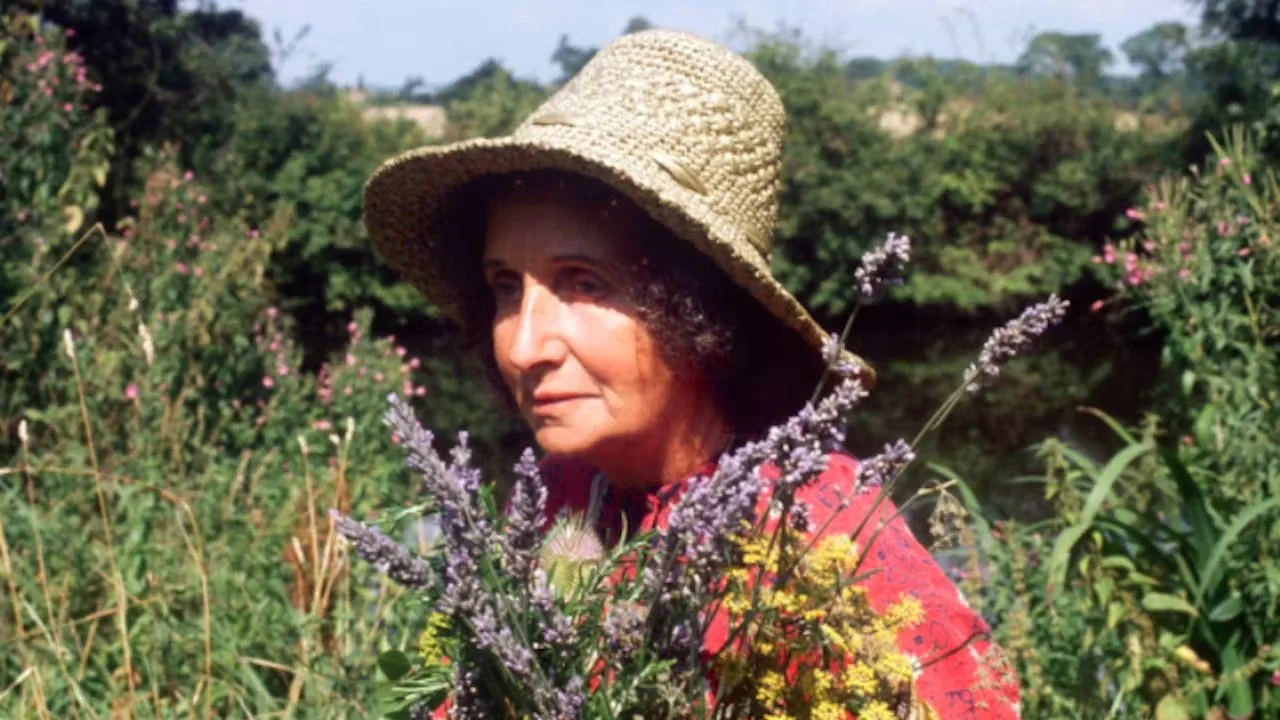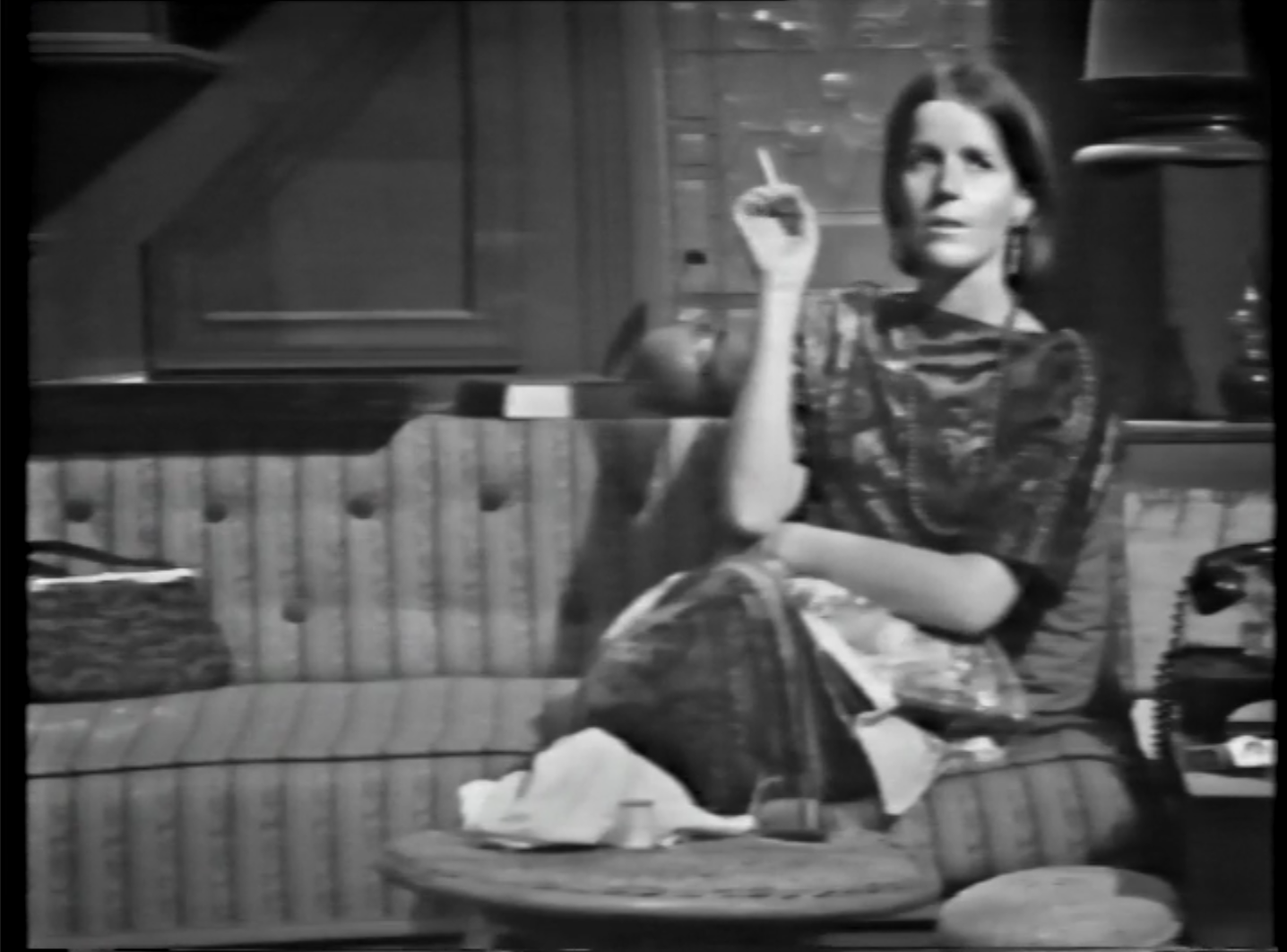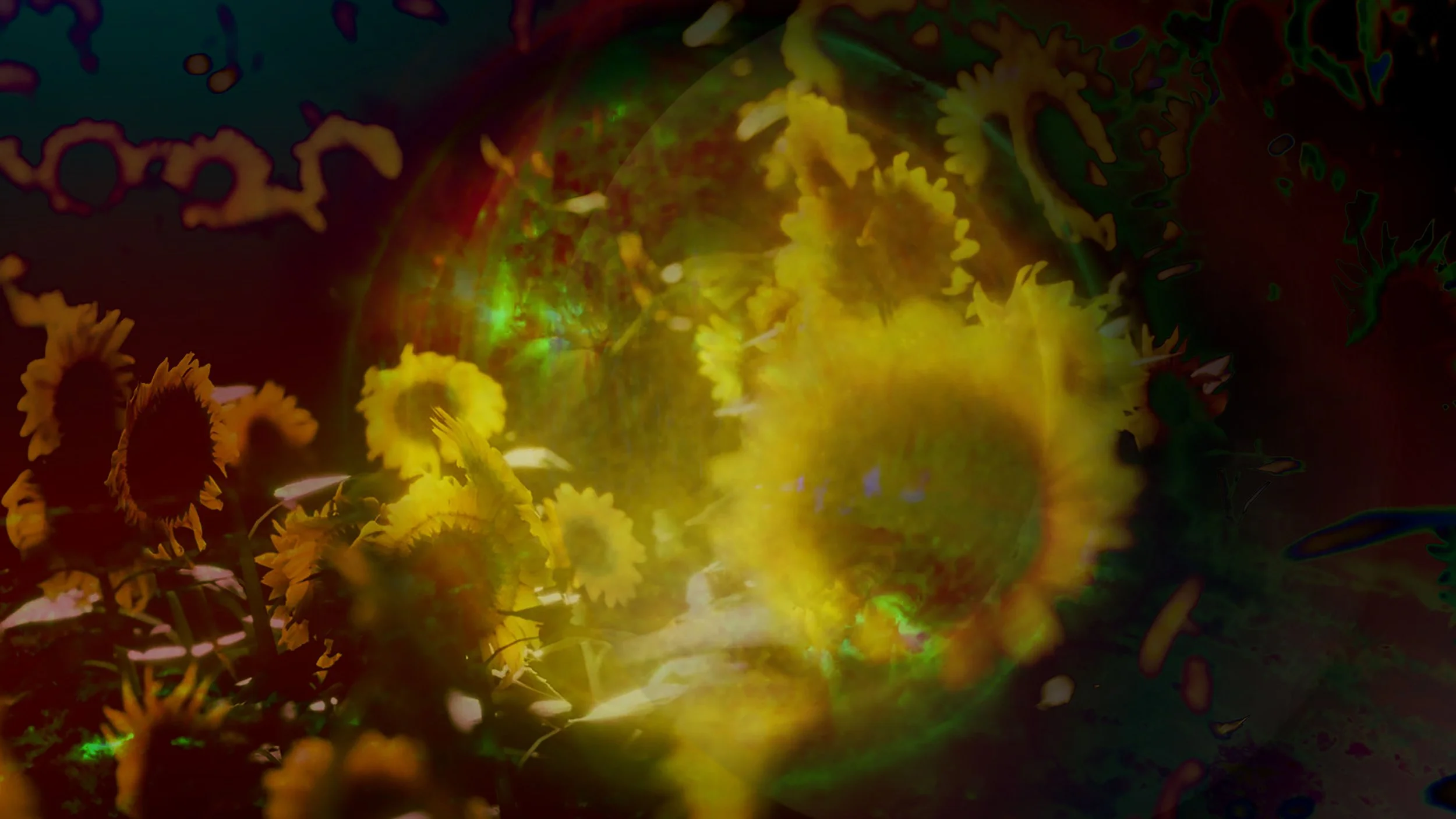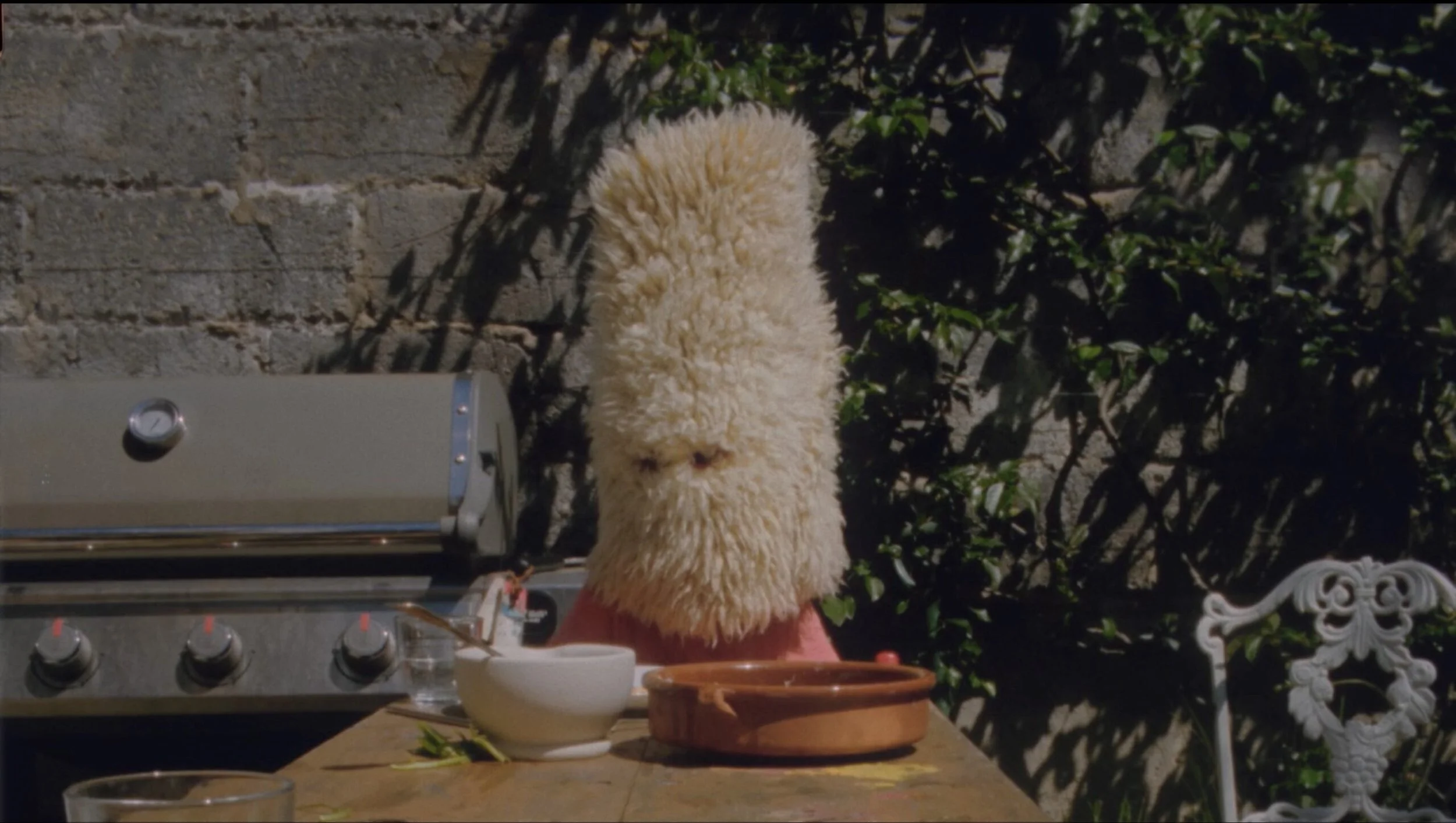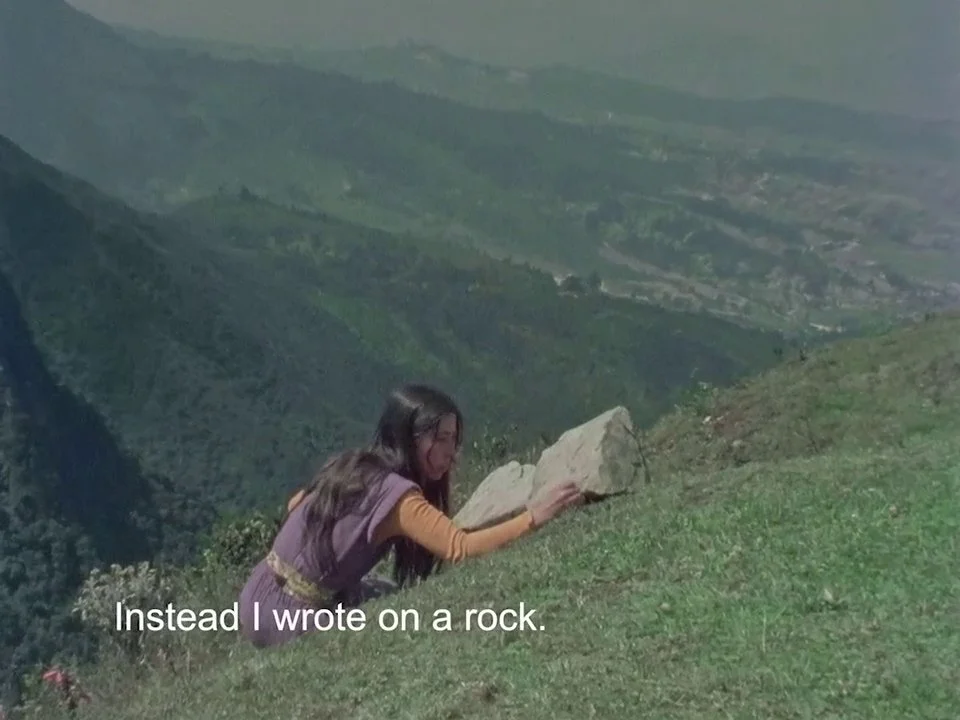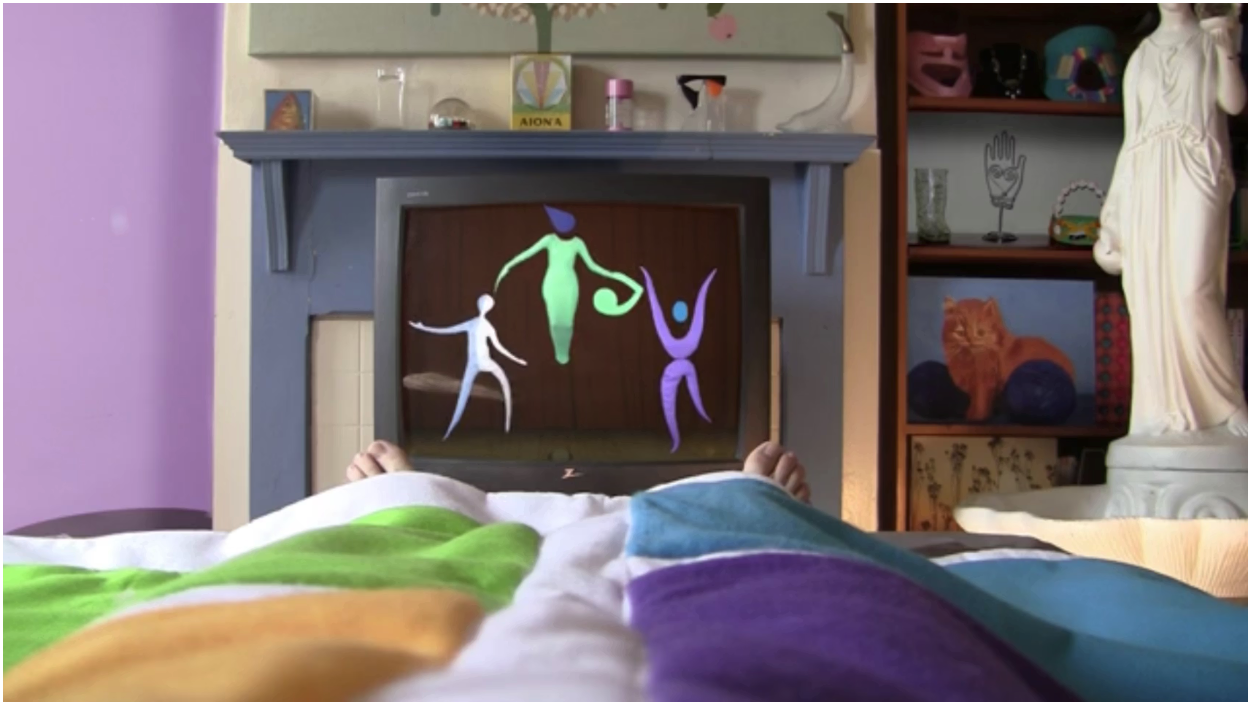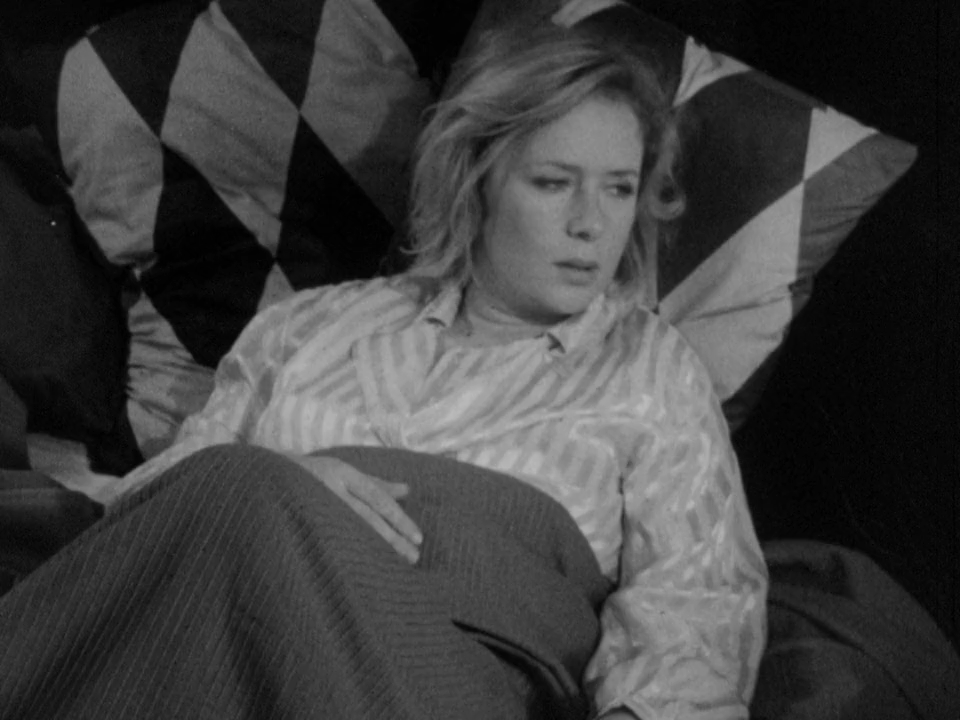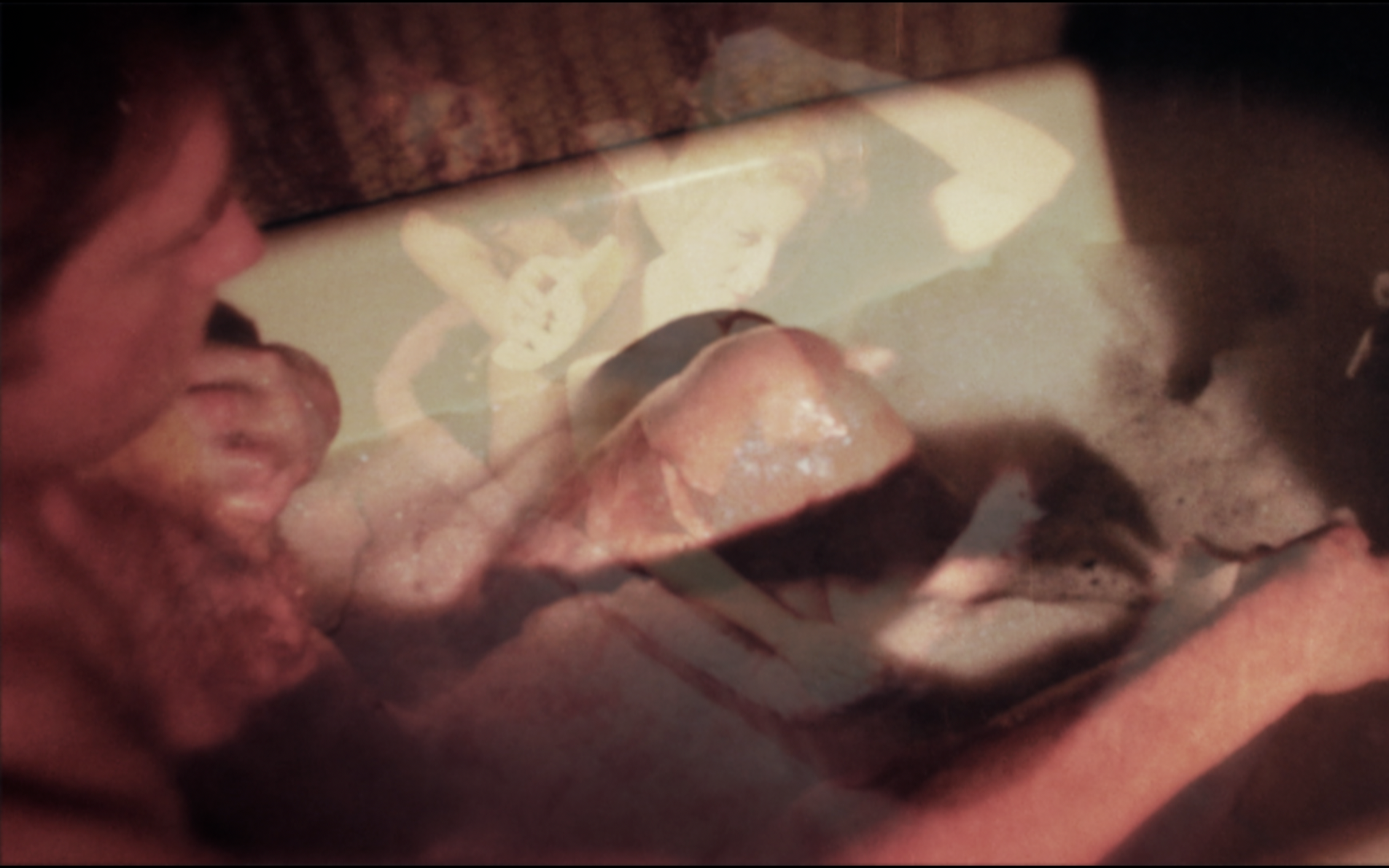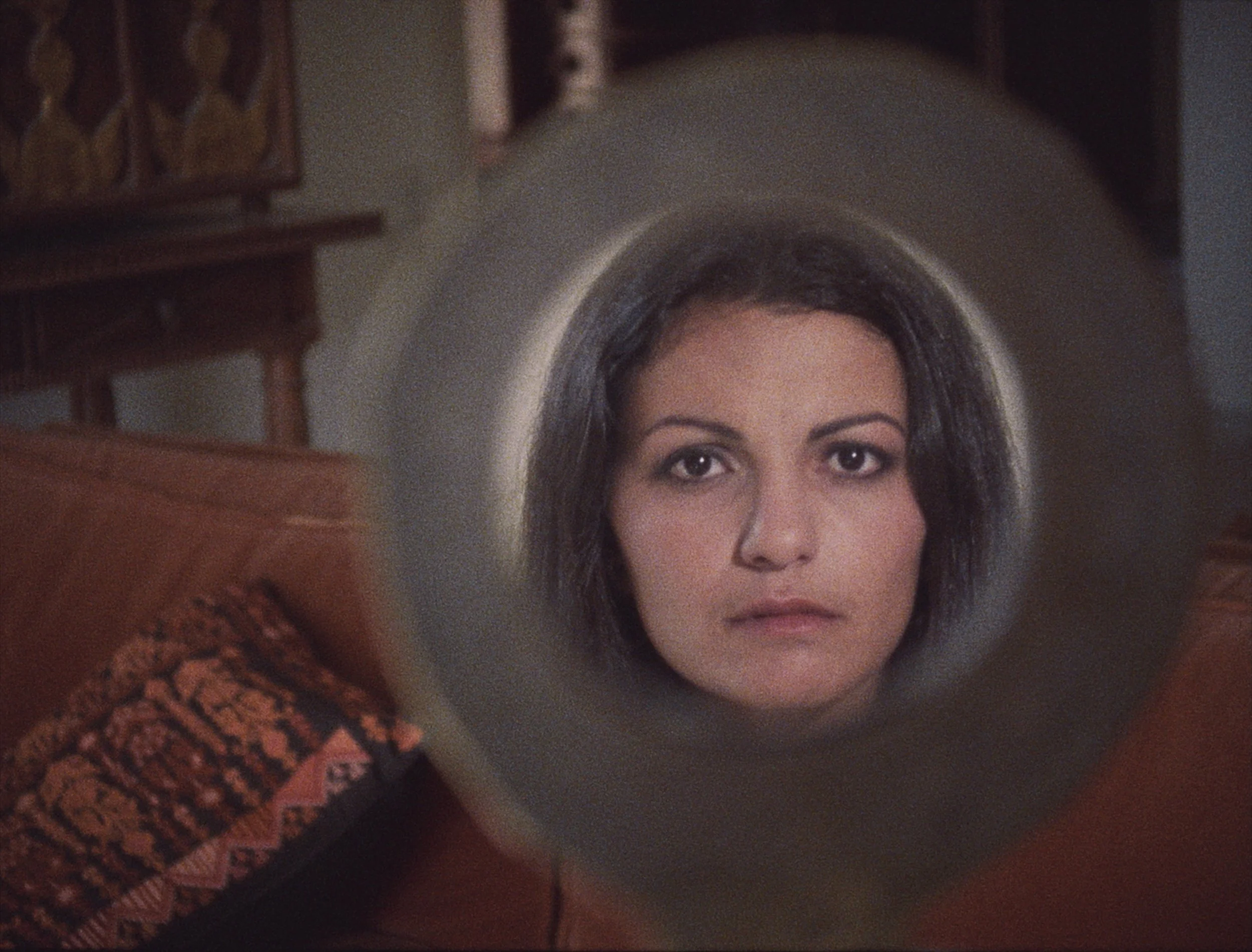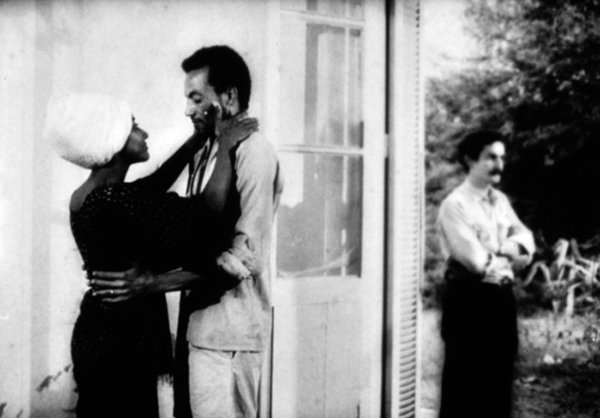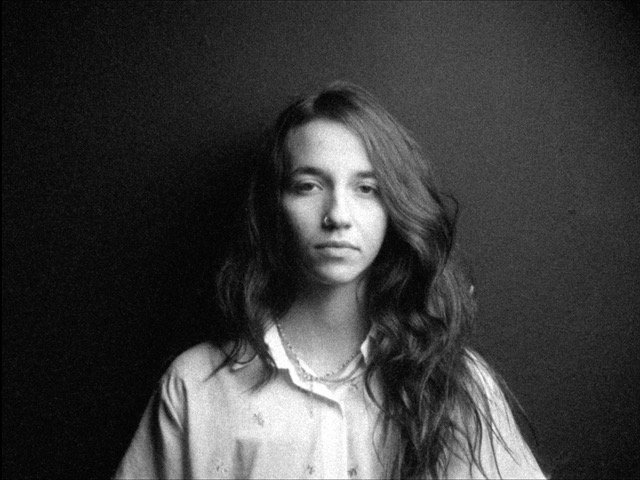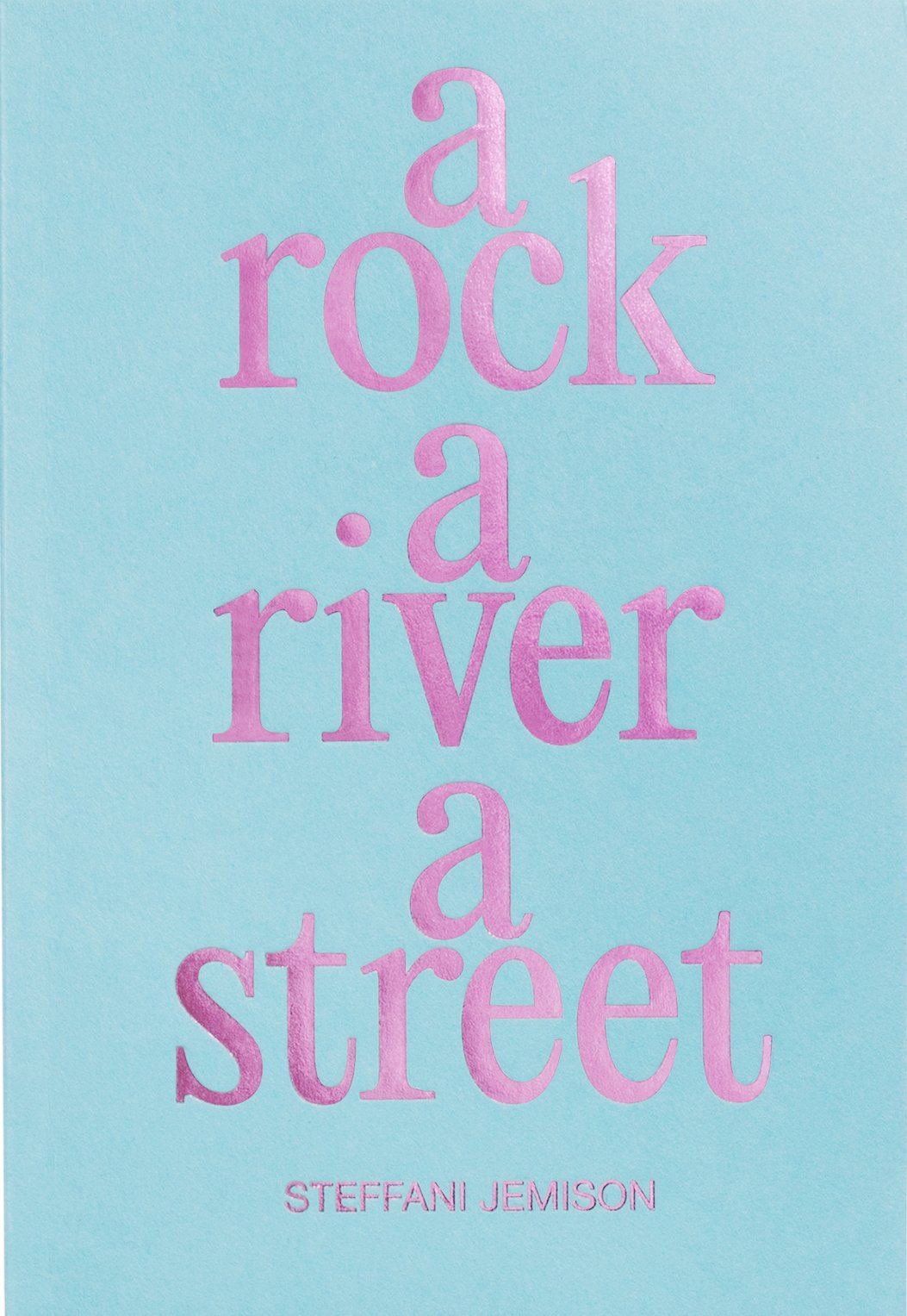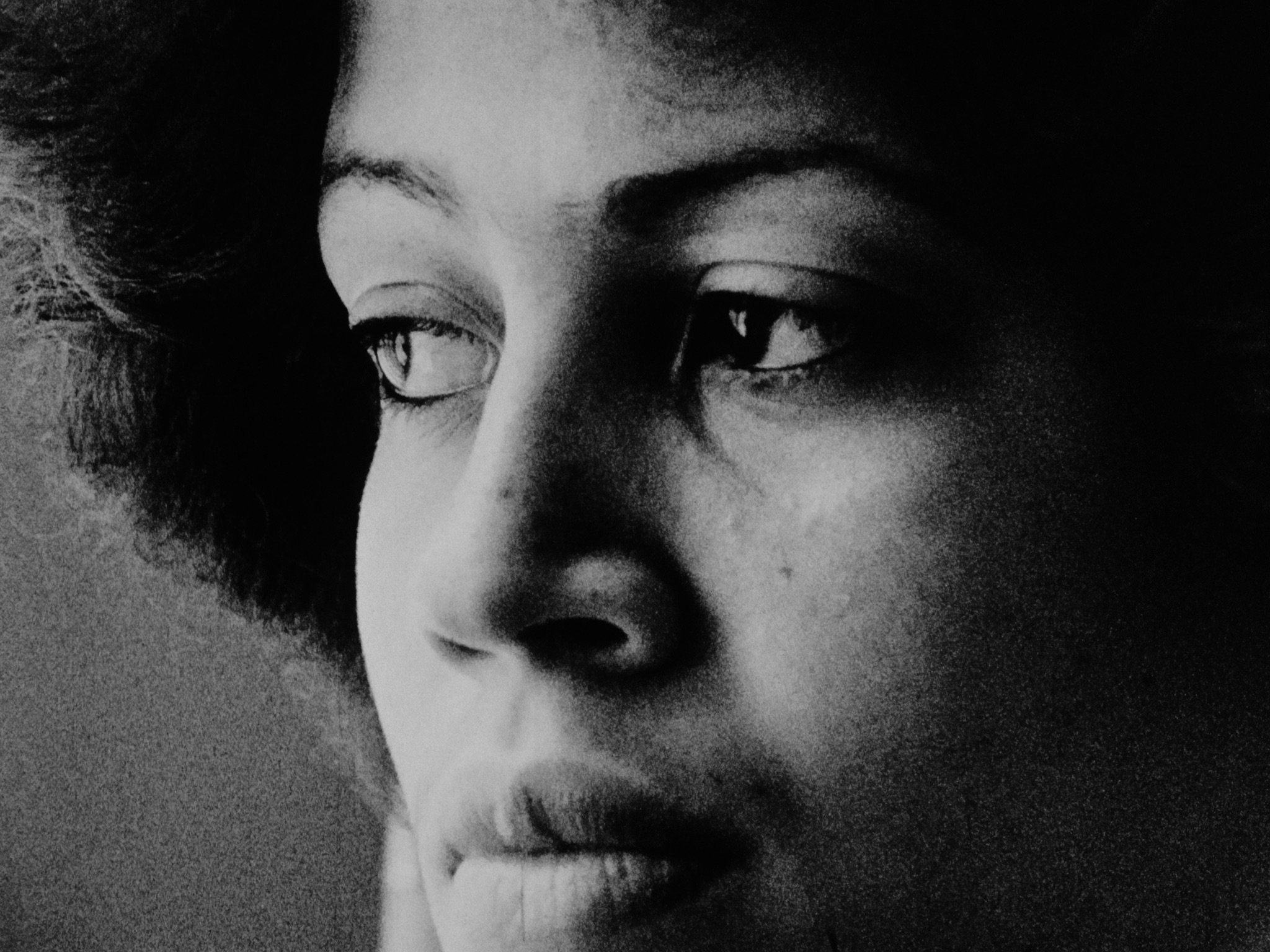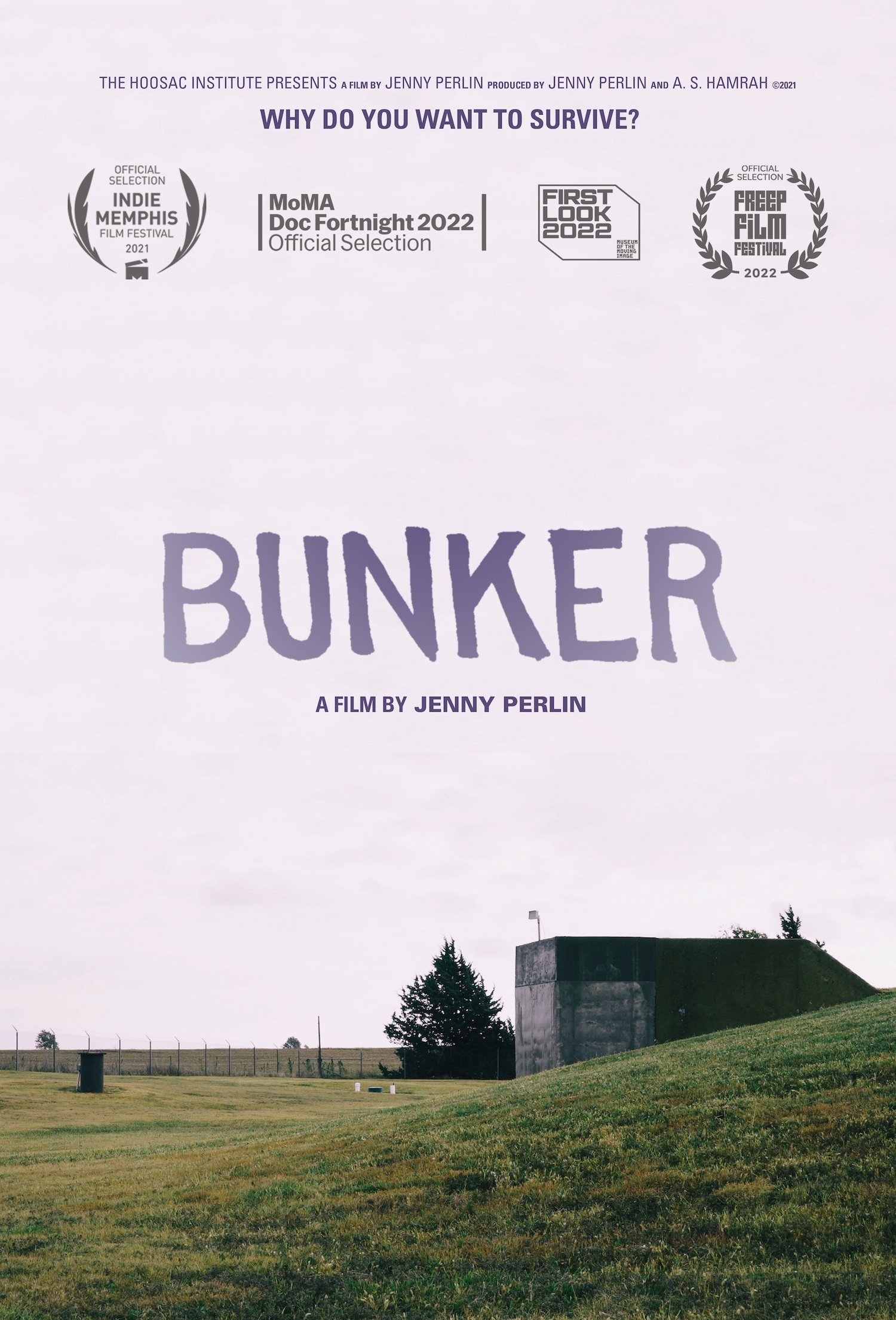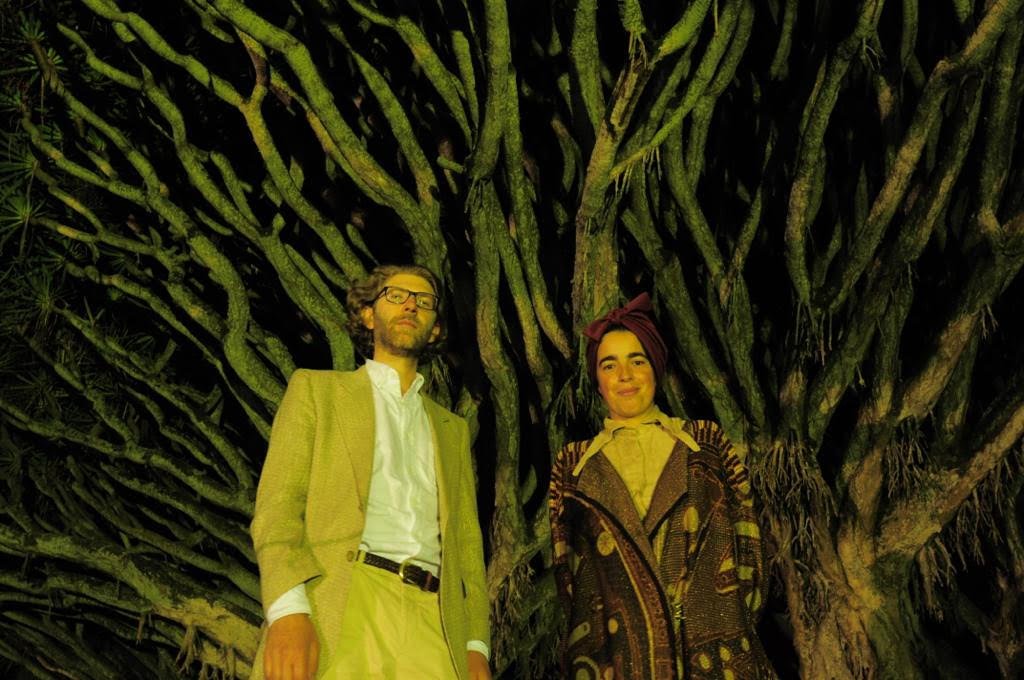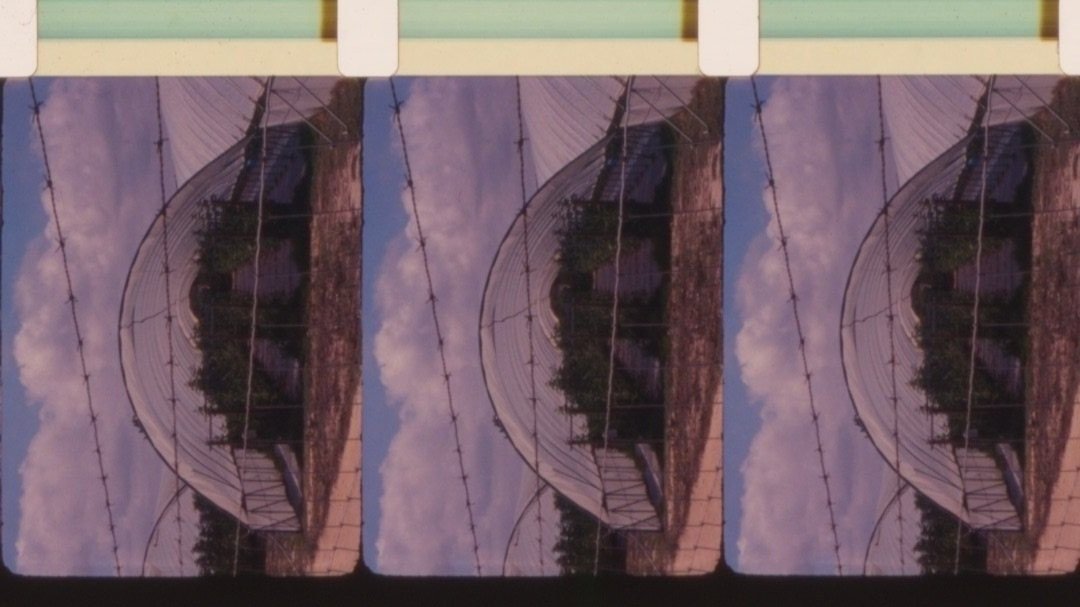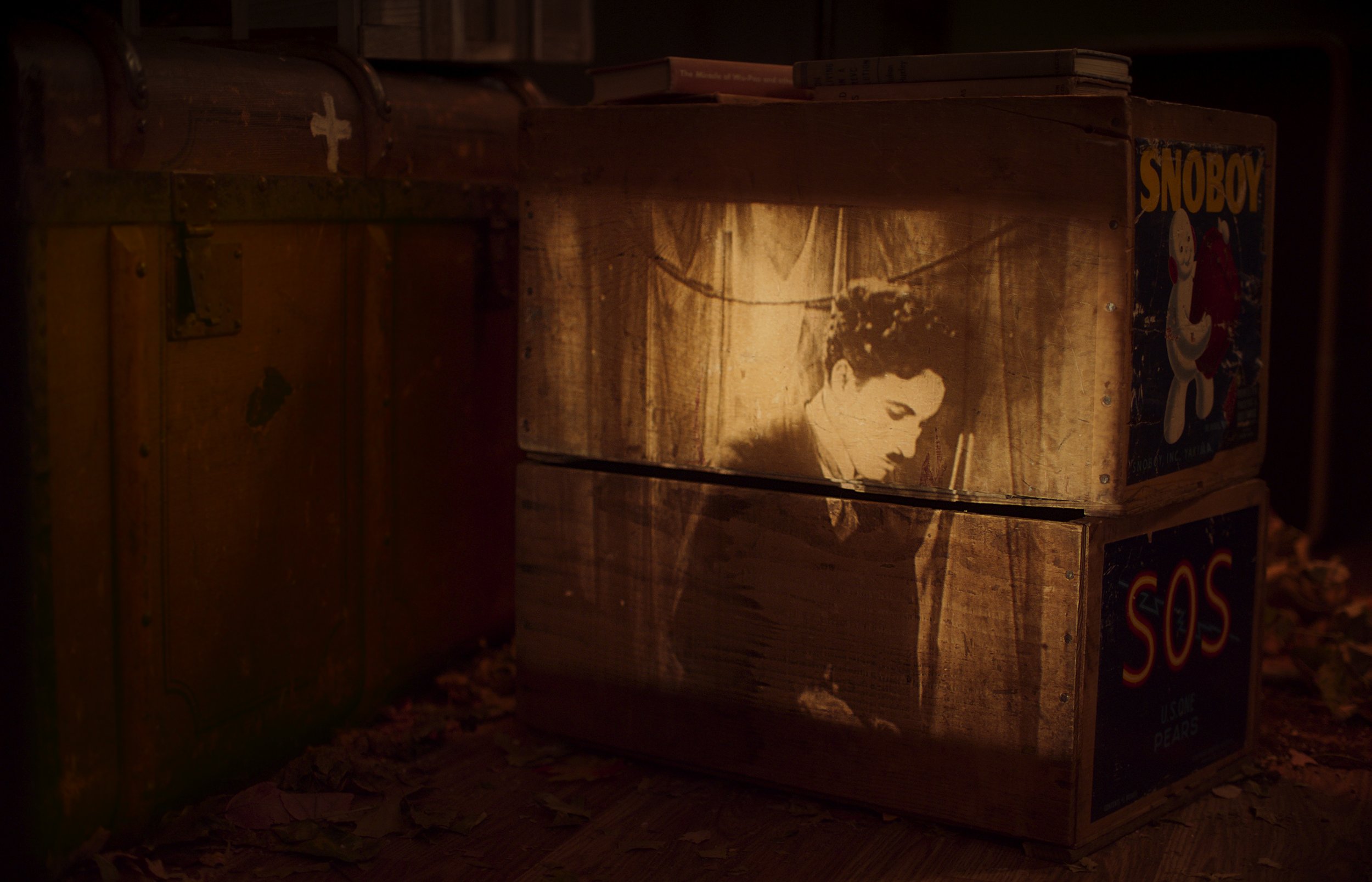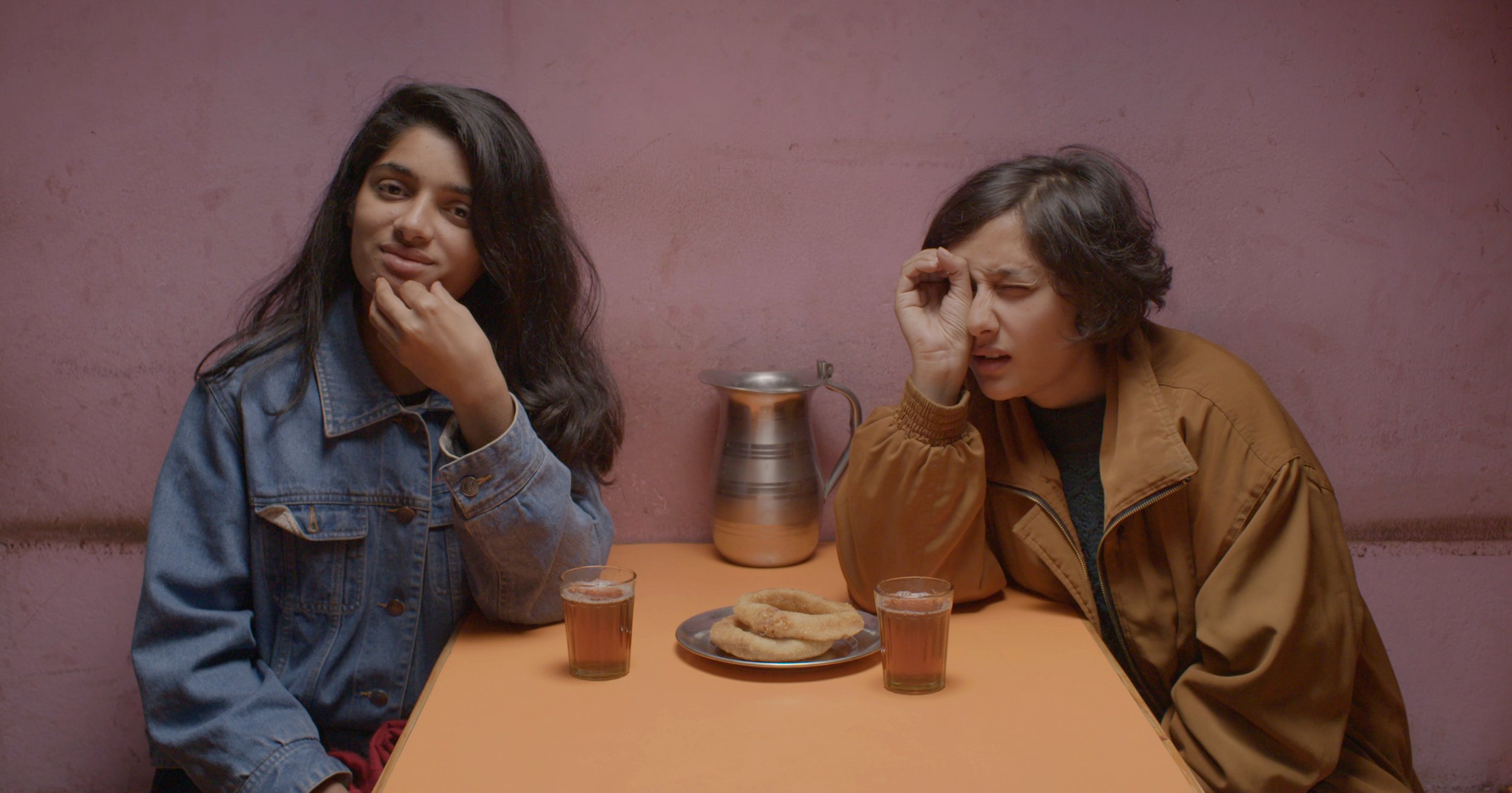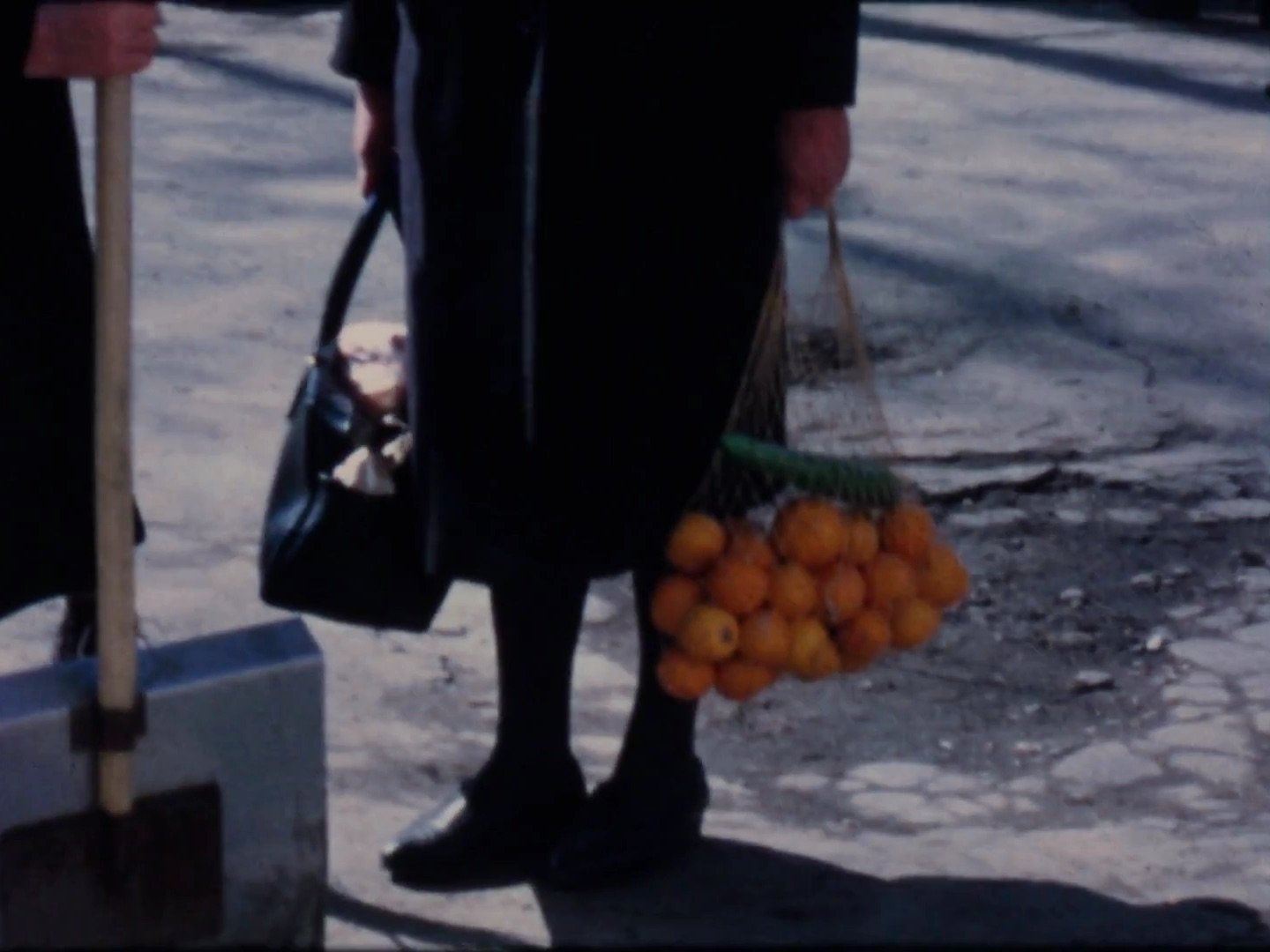Garden of Earthly Delights
November 7, 2025
1911 7th Ave., Los Angeles
Co-presentation with Veggie Cloud
Soup, herbal infusions and concoctions were served!
M*U*S*H* (2022, Dir: Jodie Mack, 8min)
In Common (2014, Dir: Adele Horne, 19min)
Juliette of the Herbs (1998, Dir: Tish Streeten, 75min)
An evening of earthly films that deal with the power, cultivation, life cycle, and lore of plants, screened in one of the most beautiful gardens in Los Angeles. Adele Horne’s In Common observes the transformation of another former vacant lot in LA into a place where the filmmaker grows and harvests food, accompanied by the scurrying of small creatures, the play of weather and light on the hillside, and the hurtling of cars across the city on the freeway below. Jodie Mack’s M*U*S*H* reframes the foliage and flowers of the garden into a prismatic procession of matter, light, and shadow on a march toward putrescence. Juliette of the Herbs, by Tish Streeten, is a lyrical portrait of the life and work of Juliette de Bairacli Levy: herbalist, author, breeder of Afghan hounds, traveler in search of herbal wisdom, and pioneer of holistic veterinary medicine.
September 19, 2025
What Is Poetry to You?
Films, video,
and archival works
directed by poets, about poets, starring poets, “about” poetry, derived in “poetry,” interrogating poetry …
A FUNDRAISING AFTERNOON & EVENING TO CELEBRATE
THE 25TH ANNIVERSARY
OF LA’S OWN
the POETIC RESEARCH BUREAU
~
2 programs
with works by
Jibade-Khalil Huffman, Simone Fattal, Anne Tardos, Lynne Tillman & Sheila McLaughlin, Ruth Beckermann, Abigail Child & Mónica de la Torre, Beatrice Gibson, Dionne Brand, Joanne Kyger, Sofia Theodore-Pierce, Guy Maddin, Shana Moulton, Cecilia Vicuña, Jackson Mac Low, Theresa Hak Kyung Cha, Sylvia Schedelbauer, & more to be announced
~
What Is Poetry to You?
Fundraising Screenings for Poetic Research Bureau
Sept. 19, 2025
Program 1: 3:00-6:00pm
Program 2: 7:00pm–9:30pm
2220 Arts + Archives
2220 Beverly Blvd., Los Angeles, CA
Full Day Pass: $25 | Per Program: $15
And on Saturday, September 20, don’t miss the poets …
Poetic Research Bureau’s 25th Anniversary Marathon Reading and Small Press Fair. Same place!
12pm - 7pm | Purchase Tickets (from $15) | Tickets are tax-deductible donations
The Dreamed Ones, Ruth Beckermann. 2016. Courtesy Grasshopper Films.
Half Halt, Sofia Theodore-Pierce. 2025.
In the Beginning, Woman Was the Sun, Sylvia Schedelbauer, 2022.
Descartes and the Splendor Of, Joanne Kyger, 1968.
Courtesy UCSD Library — Special Collections and Archives, with thanks to Donald Guravich.
Leisure, Utopic, Beatrice Gibson. 2024
Restless Leg Saga, Shana Moulton, 2012.
What Is Poetry to You? Cecilia Vicuña, 1980.
Committed, Lynne Tillman and Sheila McLaughlin, 1984.
Listening for Something … Adrienne Rich and Dionne Brand in Conversation, Dionne Brand, 1996.
John Ashbery’s ‘How to Take a Bath,’ Guy Maddin, 2009.
Day Program: Correspondences (3:00-6:00 pm)
Cecilia Vicuña, What Is Poetry to You? 1980, 23 mins.
Beatrice Gibson, Leisure, Utopic, 2024, 2 mins. —LA premiere!
Sofia Theodore-Pierce, Half Halt, 2025, 11 mins. —director in person!
Theresa Hak Kyung Cha, Paris / France / jardin, 1976, 11 mins. —rare screening!
Theresa Hak Kyung Cha, White Dust From Mongolia, 1980, 32 mins. —rare screening!
Feature: Ruth Beckermann, The Dreamed Ones, 2016, 89 mins.
TRT: 168 mins. (2 hrs. 48 mins.)
∆
Dinner break
∆
Evening Program: Commitments (7:00-10:00 pm)
Sylvia Schedelbauer, In the Beginning, Woman Was the Sun, 2022, 17 mins.
Dionne Brand, Listening for Something … Adrienne Rich and Dionne Brand in Conversation, 1996, 55 mins.
Jibade-Khalil Huffman, Good Jazz, 2017, 6 mins. —director in person!
Shana Moulton, Restless Leg Saga, 2012, 7 mins.
Feature: Lynne Tillman + Sheila McLaughlin, Committed, 1984, 76 mins. —rare screening!
TRT: 161 mins. (2 hrs. 41 mins.)
∆
Video on View in 2220 Space | Friday & Saturday
Simone Fattal, Autoportrait, 1972/2012
Abigail Child + Mónica de la Torre, To and No Fro, 2005
Anne Tardos, Animals, 1971–72
Guy Maddin, John Ashbery’s ‘How to Take a Bath,’ 2009
Joanne Kyger, Descartes and the Splendor Of, 1968
Jackson Mac Low, Jacajurismatics: Participants at Home, 1966
ABOUT THE FILMS
Cecilia Vicuña, What Is Poetry to You? 1980, 23 min.
Vicuña asks passersby on the streets of Bogotá—including fellow artists and poets, sex workers, children, a police officer, and a scientist—the question: “What is poetry to you?” The surprising answers she elicits reveal the richness of oral culture in Colombia. Courtesy of the artist and Electronic Arts Intermix (EAI), New York.
Beatrice Gibson, Leisure, Utopic. 2024, 2 min. —LA premiere!
The first in a series of the artist’s adaptations of Utopia, a book published in 1984 by the New York poet Bernadette Mayer, specifically Chapter 4: “The Arrangement.” Many thanks to Beatrice Gibson.
Sofia Theodore-Pierce, Half Halt. 2025, 11 min. —LA premiere, director in person!
In horsemanship a half halt is a pulse on the rein to say, hey I’m still here, holding you. It indicates something around the bend, a warning and a reassurance. Here, a series of interruptions are held together by those who catch me when I'm falling. Rosie reads their poem. Grace and I brave the dark. Camera breaks. Record skips. Lovers reunite through a viewfinder. We’re all filming each other on horseback. A meditation on intimacy in times of offscreen emergency, both personal and political. Seizures as elevators. (STP) Courtesy Sofia Theodore-Pierce.
Theresa Hak Kyung Cha, Paris / France / jardin. 1976, 11 min.
A rare screening of one of Cha’s film fragments in color Super-8, Untitled (Paris / France / jardin) (1976) rests with and cares for friends in domestic and garden space. Theresa Hak Kyung Cha: Courtesy University of California, Berkeley Art Museum and Pacific Film Archive, Gift of the Theresa Hak Kyung Cha Memorial Foundation. Thanks to Jon Shibata.
Theresa Hak Kyung Cha, White Dust From Mongolia. 1980, 32 min.
Theresa and her brother James Cha traveled to South Korea in 1979 and 1980—her first trips after their departure to the U.S. 17 years prior. With James as cinematographer, the siblings were there to make a film. Instead, harassed by South Korean officials suspicious that they might be North Korean spies. Years later, having abandoned White Dust from Mongolia as a film, Cha planned to turn it into a book … but the footage remains. Theresa Hak Kyung Cha: Courtesy University of California, Berkeley Art Museum and Pacific Film Archive, Gift of the Theresa Hak Kyung Cha Memorial Foundation. Thanks to Jon Shibata.
Ruth Beckermann, The Dreamed Ones. 2016, 89 min.
In 2010, the English translation of the poets’ almost 200 letters was published as Correspondence (their relationship also generated poems, postcards, telegrams and unsent drafts). A surprise bestseller in its original German, Correspondence would prompt Austrian documentary filmmaker Ruth Beckermann to make Die Geträumten (The Dreamed Ones, 2016). Beckermann uses singer-songwriter Anja Plaschg and actor Laurence Rupp reading the letters, unrehearsed, to underscore the labors involved in longing from afar (and transforming from afar—in 1959, Bachmann accused Celan of wanting to “be the victim” and refused to join him in such a path). The project, ultimately, bends the anachronistic tracing of articulation and embodiment back toward the actors as individuals themselves, creating a blur between rehearsal, document, memory, exchange, poetry, passion, and the present. Courtesy Sixpack Film, Vienna.
Sylvia Schedelbauer, In the Beginning, Woman Was the Sun. 2022, 17 min.
In the Beginning, Woman Was the Sun, 2022. Sylvia Schedelbauer. A film dedicated to Japanese feminists. One of whom, Hiratsuka Raichō, a poet whose lyricism closes out the absolutely core-warming churning of “archival images of Japanese suffragettes, woodblock paintings, calligraphy, a woman wearing a graduation cap, banners, and protestors … a film about agitation” (Millennium Film Journal). Thank you immensely to Sylvia Schedelbauer. Courtesy Sylvia Schedelbauer.
Dionne Brand, Listening for Something … Adrienne Rich and Dionne Brand in Conversation. 1996, 55 min.
Novelist, poet, essayist and documentarian Dionne Brand was instrumental in the endeavors of Studio D, the iconic workshop created by the National Film Board of Canada in 1974 to produce more films by women and about women's issues, including those that affected African-Canadian and First Nations women. Brand's documentaries included Sisters in the Struggle (with Ginny Stikeman, 1991), Long Time Comin' (1993), and Listening for Something...Adrienne Rich and Dionne Brand in Conversation (1996).
Listening for Something... is a documentary mirror. It sees “two women claim[ing] every subject as their own. They speak openly about feminism, racism, lesbianism and politics—unpacking the world as each sees it, with thoughtfulness and candour .... Shot in both black and white and colour, the film traverses not only geography but also the rich, layered terrain of their poetry,” which is interspersed throughout.
"For Brand, black poesis," writes Saidiya Hartman, “—as social practice and creative invention—has unfolded as a centuries-long refusal of the given and a ceaseless practice of transfiguration” Courtesy National Film Board of Canada.
Jibade-Khalil Huffman, Good Jazz. 2017, single channel video, color, 6 min. —artist in person!
There’s Free Jazz, there’s Jazz as Fuck; and there’s Good Jazz, playing for the first time in a theatrical setting, poetry WRIT large, no jazz hands. Good Jazz, writes critic Maya Rubio in a recent review, is “a stream-of-conscious visual poem [that] highlights Huffman’s strikingly ekphrastic poetry—a feat of interdisciplinarity that can be recognized throughout his work.” Huffman’s long-form video-collage practice bends the boundaries of each form even while excited in its occularcentrality. Courtesy Jibade-Khalil Huffman.
Shana Moulton, Restless Leg Saga. 2012, 7 min.
In this edition of Moulton's narrative series, the artist's character Cynthia suffers from Restless Leg Syndrome, and seeks relief in pharmaceutical ads on TV and in health magazines. In a domestic world enlivened with animated dance and mystic poetry (written and read by poet John Coletti), Cynthia finds relief in the healing mineral AION A, discovered by Swiss artist Emma Kunz. Courtesy Shana Moulton.
Lynne Tillman and Sheila McLaughlin, Committed. 1984, 76 min.
Writer Lynne Tillman was modest in a recent interview. "I became involved in film because I was always interested in film. I mean, if I had my druthers, I would have done everything. I loved painting..."
Tillman made Earth Angel, 5 min., 1975; Gestures, 5 min., 1978; and a feature-length film, Committed, with Sheila McLaughlin, in 1984.
Committed is a film about a film star, Frances Farmer, but also looks at the institution of psychiatry as it developed in America from the 1950s on. So goes the original press release, as found in the papers of Bérénice Reynaud a few moons ago ...*
“The double-entendre title of McLaughlin and Tillman’s movie refers not only to [Frances] Farmer’s coerced institutionalization but also to her political and artistic allegiances, the latter a not insignificant factor contributing to the former. Where Frances [the 1982 biopic starring Jessica Lange] painstakingly, if listlessly, dramatizes Farmer’s support of left-wing causes—the actress utters a perfunctory “No pasarán” at a fundraiser for the Loyalists in the Spanish Civil War—Committed conveys her beliefs through more unconventional means: by telling, not showing” (Melissa Anderson, 4Columns).
*Ask at the box office to view the original press release for Committed. Film courtesy First Run Features.
Simone Fattal, Autoportrait. 1972/2012, 46 min.
Simone Fattal, artist, founder of Post-Apollo Press. Autoportrait is an attempt at a cinematic self-portrait as well as an extensive monologue, interspersed with conversational fragments of Fattal and her friends or parents. “I wanted to do my self-portrait,” says Fattal in the video. “Although I’m a painter, I called upon two friends to make a film because I thought the language of cinema was much richer, and allowed for a longer-lasting vision.” It was not until 2012 that Simone Fattal edited these hour-long soliloquies into the 46-minute-long videowork Autoportrait. The filmic material enfolds neither linear nor logic—on the contrary, Fattal’s autobiographic project appears to become more fragmented, closer to the means of which film operates but also those of memory, confessions, and seduction (KW Berlin). With thanks to Simone Fattal.
Recommended reading: Alisa Lebow, “The Self at a Distance: Simone Fattal’s Autoportrait (1972/2012).”
Jackson Mac Low, Jacajurismatics: Participants at Home. 1966, 4:13.
A collaborative piece resembling a ‘home movie,’ featuring Carol Bege, Mordecai-Mark Mac Low, Emmett Williams, Iris Lezak, Jud Yalkut, and Mac Low.
Abigail Child & Mónica de la Torre, To and No Fro. 2005, 5 min.
From Abigail Child’s ‘Foreign Films’ series, To and No Fro was made in collaboration with poet Mónica de la Torre and Luis Bunuel’s A Woman Without Love (1952). Status and culture crack the mirror of family secrets, dreams, hauntings and wish-fulfillment in shifting and multiplying frames. Abigail Child (b.1948) has been an active filmmaker, poet and writer working in experimental media since the 1970s. Child has written six books and completed more than thirty films, videos and installations, becoming, according to P. Adams Sitney, “the central representative of her generation in the intricate and intimate relationship between poetry and cinema in the American avant-garde.” Courtesy Canyon Cinema.
Anne Tardos, Animals. 1971-1972, 5 min., color.
Anne Tardos, undersung filmmaker, studied at Vienna Film Academy from 1963-65. Author of eleven books of poetry, and editor of three posthumous collections of poetry by Jackson Mac Low. Animals is a collage video of various animal footage. Shot on video in Coney Island, San Diego Zoo, the New York Zoo, the Bronx, and Manhattan.
Joanne Kyger, Descartes and the Splendor Of. 1968, 22 min.
Joanne Kyger (1934–2017) was one of the major poets of the San Francisco Renaissance, with overlapping ties to prominent Beat, Black Mountain, and New York School poets. Created and aired on San Francisco public television in 1968 through the Experimental TV Project (later NCET), Descartes is poet Joanne Kyger’s sole video work, a psychedelic adaptation of her poem by the same name. Kyger was often associated with the male Beat poets, though she never limited herself to being of a particular school, and this poem, a reworking of René Descartes’ Meditations on First Philosophy finds her lending a female voice to Descartes’ mind/body problem. Like Descartes, she “resolved to make [her] own self an object of study” - but instead of applying skepticism to the illusory nature of forms, but Kyger’s work of electronic formalism explores the metaphysics (and illusionistic potential) of the video screen. (Adapted from “In the Beginning There Was the Electron”, Kris Paulsen, X-TRA, with thanks to The Flaherty). Courtesy UCSD Library’s Special Collections & Archives.
Guy Maddin | John Ashbery’s ‘How to Take a Bath,’ 2009, 3 min.
Poet John Ashbery wrote his own adaptation of the long-lost Dwain Esper exploitation film How to Take a Bath, which Maddin then filmed. The finished film, John Ashbery’s How to Take a Bath, is included in Maddin’s feature, The Forbidden Room, which has been described as “a film treatment in collage.” When talking about their shared love of collage-making, Maddin remarked “…I suppose this gluey and scissory medium is where the sensibilities of each other’s chosen fields come closest … where we unroll for the public the secret blueprints for the little visual collisions….” (Tibor de Nagy) Courtesy Guy Maddin.
These programs would not have been possible without Joseph Mosconi, Andrew Maxwell, the PRB, and 2220; Cecilia Vicuña; EAI; Anne Tardos; Sylvia Schedelbauer; Lynne Tillman; Sofia Theodore-Pierce; Jibade-Khalil Huffman; Shana Moulton; Beatrice Gibson; Simone Fattal; David Buuck; Guy Maddin; Canyon Cinema and Zachary Epcar; Dionne Brand, Courtesy National Film Board of Canada; UCSD Library — Special Collections and Archives, with thanks to Donald Guravich and Nina Mamikunian; The Dreamed Ones: Courtesy Sixpack Film. Theresa Hak Kyung Cha: Courtesy University of California, Berkeley Art Museum and Pacific Film Archive, Gift of the Theresa Hak Kyung Cha Memorial Foundation. Install help: Ali Vanderkruyk.
March 21 and 22, 2025
Los Angeles Premiere
WHEN
THE PHONE
RANG
IVA RADIVOJEVIC
in person!
When the Phone Rang
2024. DCP 2K · Color · 73 mins.
In Serbo-Croatian with English ST.
Now Instant Image Hall
939 Chung King Rd, Los Angeles, CA
Q+As with the director to follow both screenings.
Rotations is thrilled to welcome back filmmaker Iva Radivojevic for the two-night Los Angeles premiere of her new film, When the Phone Rang (Kada je zazvonio telefon), made in the filmmaker’s native Serbia. Through an intimate reconstruction of an important phone call, When the Phone Rang investigates dislocation and the nature of remembering. In the protagonist’s 11-year-old mind, this phone call erases her entire country, history, and identity and hides its existence in books, films, and memories of those born before 1995.
“If we consider one of the aims of war to be the destruction of memory, eradicating culture’s memory and collective existence, then these private, unwritten accounts act as counter-memory, surviving despite the attempts of erasure and preserving narratives outside of national and nationalistic (authoritative) agendas.” —Iva Radivojevic
About the filmmakers
Director, writer, editor, music: Iva Radivojevic
Producers: Andrijana Sofranis Sucur, Marija Stojnic, Madeleine Molyneaux, Iva Radivojevic
Co-producer: Genoveva Petrovits
Cinematographer: Martin DiCicco
Sound Design & Mix: Leandros Ntounis (I Heard Voices - Athens, Greece)
Camera Assistant and Loader: Bojan Durisic
Gaffer: Viktor Minic
16mm Film Lab Processing NFI
Sound Recordist Bojan Palikuca
Color Dimitris Karteris - Athens, Greece
Mastering / DCP Chris Karteris - Athens, Greece
Cast: Natalija Ilinčic, Srna Vasic, Vasilije Zečevic, Danica Maksimovic, Anton Augustinov, Mila Drobnjak, Dunja Vladisavljevic, Ivana Pančic, Ibro Sakic, Slavica Bajčeta
With thanks to Madeleine Molyneaux and Picture Palace Pictures, Ivaasks Films, Set Sail Films, Lights On, and California Institute of the Arts School of Film/Video.
March 17, 2025
Encore screening!
LEILA AND THE WOLVES
HEINY SROUR in person!
Leila and the Wolves
Heiny Srour. Lebanon, Palestine, 1984.
90 minutes.
In Arabic with English ST.
Screening followed by a Q+A with Heiny Srour and Fariha Róisín.
Written in 1979 and not completed until 1984, Leila and the Wolves is Lebanese feminist filmmaker Heiny Srour’s only feature-length fiction film. A wholly inventive reinscription of Arab women into collective, colonialist, and patriarchal memory, Leila was shot during the harrowing Lebanese and Syrian civil wars. The film employs song, folklore, reenactment, archival footage, multiple oral histories, and feminist perspicacity to construct a journey for the Lebanese Leila (Nabila Zeitoni), a student who time-travels from her photography exhibition in 1980s London, to Palestine at the turn of the 20th cent., and otherwise into colorfully constructed liberatory space.
Leila and the Wolves has been restored by CNC – Centre national du cinéma et de l’image animée and has received new U.S. distribution with indie distributor Several Futures.
Presented with Mezzanine and Several Futures.
Following its first-ever, sold-out Los Angeles screening at Rotations in May 2024, this encore screening of Leila and the Wolves welcomes the legendary Heiny Srour herself, who will be in LA after the film screens in Brooklyn, Dallas, and Cleveland, and before heading to Canada.
About filmmaker Heiny Srour
Heiny Srour is a Lebanese filmmaker born in Beirut in 1945, known for being the first Arab woman filmmaker to have a film selected for the Cannes Film Festival, The Hour of Liberation Has Arrived. Srour studied Social Anthropology in Paris and later worked as a journalist and film critic. She has long been interested in Third World cinema and the role of Arab women in revolutions.
About moderator Fariha Róisín
Fariha Róisín is a multidisciplinary artist, born in Ontario, Canada. She was raised in Sydney, Australia, and is based in Los Angeles. As a Muslim queer Bangladeshi, she is interested in the margins, in liminality, otherness and the mercurial nature of being. Her work has pioneered a refreshing and renewed conversation about wellness, contemporary Islam and queer identities and has been featured in Al Jazeera, The Guardian, and Vogue. She is the author of the poetry collection How To Cure A Ghost (2019), as well as the novel Like A Bird (2020), Who Is Wellness For? (2022) and her second book of poetry is entitled Survival Takes a Wild Imagination, due fall 2023.
About distributor Several Futures
Several Futures is a North American Film Distribution company founded in 2022 by filmmaker Graham L. Carter, with a goal of bringing auteurist and anti-imperialist films to the U.S. and Canada.
December 18–19, 2024, 7:00 p.m.
Now Instant Image Hall, Los Angeles
THE GROUNDBREAKING JOCELYNE SAAB
+ Traces, Chantal Partamian
Jocelyne Saab (1948–2019) was one of the most multifaceted filmmakers of her generation. Belonging both to the world of journalism and to the second wave of Arab feminists, for whom visibility and language both functioned as “poetic testimony” more than narration, Saab dedicated approximately fifteen documentaries to the subject of the civil war in Lebanon (1975–1990): New Crusader in the Orient, 1975; Lebanon in Turmoil, 1975; Children of War, 1976; South Lebanon, History of a Sieged Village, 1976; Beirut, Never Again, 1976; For a Few Lives, 1976; Letter From Beirut, 1978; Beirut, My City, 1982; The Lebanese, Hostages of their City, 1982; The Ship of Exile, 1982; Lebanon, State of Shock, 1982; The Woman Killer, 1988; as well as one fiction film: A Suspended Life, 1985.
Saab became a reporter and television presenter after studying political economy in her own city of Beirut and in Paris, before the war; and turned defiantly to independent filmmaking and the construction of images in Beirut when the war began in 1975. Attuned, like her friend and collaborator Etel Adnan, to different tools of bearing witness, Saab created her own documentary of dissidence and solidarity. Alongside the long-neglected and mostly undistributed work of Heiny Srour, Assia Djebar, Mai Masri, Atteyat Al-Abnoudy, and other female filmmakers of the Maghreb and Mediterranean Arab region, Saab’s oeuvre clears a path for artistic representation in times of ongoing, overwhelming emotion and unholy Israeli occupation and land-seizure.
Over the course of two nights, Dec. 18–19, Rotations presents THE GROUNDBREAKING JOCELYNE SAAB, a program screening at Now Instant Image Hall in Los Angeles. Featuring all three documentaries in Saab’s THE BEIRUT TRILOGY (1976, ‘78, ‘82) as well as her narrative feature A SUSPENDED LIFE (1985)—accompanied by TRACES (2023), a new, stunning film from Lebanese–Canadian experimental filmmaker and archivist Chantal Partamian—we hope to cast light on the realities of a region that once had to throw its already multilingual artists and writers, “like a destroyed building,” in all directions.
December 18
Beirut, Never Again, 1976, 35m
The year 1976 marks the beginning of Beirut’s Calvary. With a child’s eyes, the filmmaker follows for six months the daily destruction of the city’s walls. Every morning, between 6 and 10 a.m., she roams Beirut while the militia on both sides rest from their night of fighting. (MR)
Director: Jocelyne Saab, Commentary: Etel Adnan, DOP: Hassan Naamani, Jocelyne Saab, Editor: Philippe Gosselet, Voice-over (English version): Jocelyne Saab, Voice-over (French version): Jörg Stocklin, Production: Jocelyne Saab, Copyright: Nessim Ricardou-Saab.
Letter from Beirut, 1978, 52m
Imagine traveling dozens of countries in less than five hours: Nepal, Nigeria, Norway, France—and Lebanon, its fragmented identity, fragmented memory?
Three years after the start of the civil war, the filmmaker returns to her city for several months. Living between this war-torn country and a country in peace, she tries to readapt to daily life in Beirut. Public transport in the city no longer exists, but the filmmaker gets an old bus up and running, provoking a disconcerting return to normality in this city at war: people climb onto the bus, which they see as a place of security. (MR)
Director: Jocelyne Saab, Commentary: Etel Adnan and Jocelyne Saab, DOP: Olivier Guéneau, Sound: Mohamed Awad, Editor: Philippe Gosselet, Production: Jocelyne Saab, Copyright: Nessim Ricardou-Saab.
Beirut, My City, 1982, 37m
In July 1982, the Israeli army laid siege to Beirut. Four years earlier, Jocelyne Saab saw her 150-year-old childhood home go up in flames. She asked herself: When did all this begin? Every place becomes a historical site and every name a memory. (MR)
Director: Jocelyne Saab, Commentary: Roger Assaf, DOP: Jocelyne Saab, Assistant: Mirwan Khoury, Editor: Philippe Gosselet, Music: Rafic Boustani, with the participation of: Hassan Naamani, Jean-Marie Anglès, Dina Haidar, Boutros Rouhana, Mixing: Paul Bertault, Lab: AUDITEL, Production: Jocelyne Saab, Copyright: Nessim Ricardou-Saab.
DCP ALL
December 19
A Suspended Life, 1985, 90m
Samar is a young girl born during the war. Forced to live as a nomad, she grows up among fighters, learning to live in a country at war. The daily challenges she faces in life contrast with her love of Egyptian romantic comedies. One day, a chance meeting with Karim brings these two parts of her life together. A love story at the heart of a war. (MR)
Director: Jocelyne Saab, Script: Gérard Brach, Translation: Tahar Ben Jelloun, DOP: Claude La Rue, Music: Siegfried Kessler, Actors: Jacques Weber, Hala Bassam, Juliet Berto, Production: Balcon Productions, Copyright: Nessim Ricardou-Saab. DCP.
PRECEDED BY
Traces | Chantal Partamian | Lebanon, Canada, 2023, 9m
16mm D2F | 1440x1080 | 8'45” | 23.98 fps
Super8mm/Found footage
Beirut 1980: Amid the rubble of a torn building, a reel of pornographic film. An unlikely unraveling of queer bodies writes sensuality into the war-torn city, its glitching masculinity. “What if,” asks Partamian upon finding the footage, “we bring it to life, as if the disintegrated lives of queer women that were meant to stay unseen or disfigured or left to rot slowly … assert their presence within the context of the 80s in Lebanon, a period so overtly represented by war and violence and from which all narrative about personal lives and intimacy is removed?”
With gratitude to Association Jocelyne Saab, Mathilde Rouxel, and Chantal Partamian.
Chantal Partamian is an experimental filmmaker and archivist. Her work uses mainly super 8mm and found footage. Her archival activities are centered on the preservation and restoration of reels from the Eastern Mediterranean, associated with research focused on archival practices in conflict regions. Partamian's films have been presented and awarded at numerous festivals. Her writings are published in Revue Hors-Champ.
Screening History of Traces…. | Queer Lisboa & Queer Porto International Queer Film Festival | BFI Flare: London LGBTIQ+ Film Festival | 12G twelve gates arts: Contemporary Video Art Exhibition | Experimental Film Guanajuato | WNDX Festival of Moving Image | Cinema Queer Stockholm | RIDM, Montreal Experimental Documentary Festival
December 3, 2024, 7:30 p.m.
2220 Arts + Archives, Los Angeles
Notes on Displacement, Khaled Jarrar
+ Moonscape, Mona Benyamin
Q&A with Khaled Jarrar and Crystal Murphy
Mona Benyamin (b.1997) is a visual artist, filmmaker, and writer based in Palestine. In her works, she explores intergenerational outlooks on hope, trauma, and different temporalities. Through appropriating formats from mass and popular media and tampering with their apparatuses, and utilizing dark humor, she questions notions of authenticity and veracity, and challenges concepts of agency and victimhood. Her recent works have been screened at MoMA, REDCAT, Sheffield DocFest, The Mosaic Rooms, Columbia University, and elsewhere.
Q&A moderated by Crystal Murphy, Assistant Professor of Political Science, Chapman University. Dr. Murphy is affiliated with the Peace Studies Department, is Director of the MA in International Studies program, and co-Director of the Chapman Olive Tree Initiative chapter. Her research focuses on conflict, humanitarianism and development, and advocates qualitative methods for policy oriented scholarship.
Khaled Jarrar was born in Jenin, Occupied Palestine in 1976. He lives and works in Ramallah. Jarrar completed his studies in interior design at Palestine Polytechnic University in 1996. Upon graduating he smuggled himself to work as a carpenter in Nazareth, living as an underground “illegal” worker. In 1998 Jarrar enlisted in an intensive military training which resulted in working for Arafat as a personal body guard until Arafat’s death in 2004. Attempting to create a life between the military and an artistic practice, Jarrar entered the field of photography in 2005. Jarrar graduated from the International Academy of Art – Palestine, Ramallah in 2011 and completed an MFA in fine art from the University of Arizona in 2019.
Notes on Displacement. Palestine, Germany, Qatar, 2022. 74 min.
Notes on Displacement follows a single Palestinian family on a grueling journey: destination Germany. Nadira has been a refugee since the age of 12. Now she has to evacuate Damascus, too. She and her daughter Mona feared for their lives there, but the idea of a safe existence elsewhere is a distant dream. Filmmaker Khaled Jarrar receives unsettling videos and voice messages as they cross to the Greek island of Lesbos. He joins them there, on the long road to a new life. Jarrar has personal reasons for going through this experience—can he shore up, through his own images, the distance so dominant in Western media coverage? Jarrar gets lost in the night with his group, discovers how dangerous language barriers can be, and wanders the dehumanizing camps. And in a sense he—alongside the viewer—becomes a true member of this family.
Preceded by
Moonscape
Mona Benyamin. Palestine, 2020. 17 min.
Moonscape takes the form of a music video for a middle-of-the-road ballad, a duet in Arabic. The song traces the story of Dennis M. Hope, who claimed ownership of the moon and founded the Lunar Embassy, a company that sells land on celestial bodies. We find a connection between his story and that of the director—a young Palestinian woman living under the Israeli occupation, longing to end the misery of her people.
CAST & CREDITS
Cast: Nahia Benyamin, Michel Benyamin
Editor: Juna Suleiman and Mona Benyamin
Original music by Mona Benyamin; composed by Deema Azar, Loay Srouji and Ghassan Diab
Original music performed by Deema Azar and Loay Srouji
Mixing and mastering by Adham Darweesh
Prismatic Ground:
West Coast Showcase
Presented by Rotations and LA Filmforum
Sunday, June 2
2220 Arts + Archives
1:00, 4:00, 7:30
Filmforum and Rotations are delighted to host curator Inney Prakash and multiple filmmakers for a showcase highlighting the superb Prismatic Ground. Based in New York City, Prismatic Ground is a film festival centered on the best in contemporary and underseen classic cinema. This special, west-coast showcase features a selection of work by filmmakers featured in previous editions of the festival. From Palestine to India to Angola, Egypt, and Los Angeles, these artists address matters of personal grief, religious nationalism, settler-colonialism, and capitalist excess with startlingly innovative and self-aware approaches to the moving image and its possibilities.
Screening all in one day at 2220 Arts + Archives, across three separate programs, these powerful films demonstrate the breadth and depth of the festival’s curatorial vision, and bring to LA some recent highlights of artist cinema, including a new film by Suneil Sanzgiri, Two Refusals (Would We Recognize Ourselves Unbroken?).
-
Nehal Vyas, Amma ki Katha
Razan al-Salah is a Palestinian artist and teacher based in Tiotiake/Montreal. Her films work with the material aesthetics of appearance and disappearance of indigenous bodies, narratives and histories in colonial image worlds. She often works with sound-images to infiltrate borders that have severed us from the land. Her films are both ghostly trespasses, and seeping ruptures, of the colonial image that functions as a border, as a wall. She thinks of her creative process as a circle of relations with artists, friends, family, technology, images, plants, objects and sounds. These relations become different points of entry and exit into elsewheres here, where colonialism no longer makes sense.
Kamal al-Jafari is a Palestinian filmmaker renowned for his distinctive approach to cinema. After studying at the Academy of Media Arts in Cologne, he now resides in Berlin, Germany. al-Jafari has shared his expertise in filmmaking through teaching positions at The New School in New York and the Deutsche Film und Fernsehakademie in Berlin. His contributions to the field were recognised with fellowships at the Film Study Center – Radcliffe Institute at Harvard University, and most recently at the Institute for Ideas and Imagination, Columbia University 2024–2025.
In May 2024, IndieLisboa will highlight his contributions to cinema by dedicating its retrospective section to his work, to take place at the Portuguese cinematheque. Additionally, his installation “The Camera of the Dispossessed” was showcased at the 35th Bienal de São Paulo (2023). His film, A Fidai Film, won the grand jury prize at Visions du Réel 2024. He is currently developing a fiction film set to be shot in Jaffa.
Born stateless and of Palestinian heritage, artist/filmmaker Basma al-Sharif explores cyclical political histories and conflicts. In films and installations that move backward and forward in history, between place and non-place, she confronts the legacy of colonialism through satirical, immersive, and lyrical works.
Sarah Maldoror was born in 1939 in Candou, France. A Guadeloupean of African descent, she is respectfully regarded as the matriarch of African cinema (she was the first woman of color to make a feature film). For her, filmmaking was a weapon for struggle and liberation from the very beginning of her experiences in cinema. Though before embarking on a career in filmmaking she co-founded the theatre group Compagnie d’Art Dramatique des Griots in Paris in 1956. She left the company in the early 1960s to study cinema in the Soviet Union at VGIK in Moscow on a scholarship—there she met Ousmane Sembène who was also studying at the time. Maldoror worked both as an assistant director and a director in Paris, Martinique, and Portuguese-speaking African countries. After residing briefly in Morocco in 1963, she went to Algeria to work as Gillo Pontecorvo’s assistant on the 1966 classic film, The Battle of Algiers, the prototype for all mainstream political cinema of the 1970s. Her 1968 debut film Monagambée, which examines torture techniques used by the French in the Algerian war, was selected for the Quinzaine des réalisateurs / Directors’ Fortnight at Cannes in 1971. The following year she made her emblematic œuvre, Sambizanga, which relates a woman’s experience during the Angola liberation struggle. The film shared the prestigious Tanit d’Or prize at the Carthage Film Festival that same year. Pioneer, trailblazer, mentor, Sarah Maldoror had this to say in an interview with Jadot Sezirahiga: “African women must be everywhere. They must be in the images, behind the camera, in the editing room and involved in every stage of the making of a film. They must be the ones to talk about their problems”. Maldoror's work is often included in studies of the role of African women in African cinema. Maldoror passed away in France in April 2020, at the age of 90, from COVID-19.
Suneil Sanzgiri is an artist, researcher, and filmmaker. Spanning experimental video and film, animations, essays, and installations, his work contends with questions of identity, heritage, culture, and diaspora in relation to structural violence and anticolonial struggles across the Global South. Sanzgiri’s films offer sonic and visual journeys through family history, local mythology, and colonial legacies of extraction in Goa, India—where his family originates. His first institutional solo exhibition Here the Earth Grows Gold opened at the Brooklyn Museum in October 2023. His films have circulated widely at film festivals and art institutions across the world, including International Film Festival Rotterdam, New York Film Festival, Hong Kong International Film Festival, Camden International Film Festival, Sheffield Doc/Fest, DocLisboa, Viennale, BlackStar Film Festival, Open City Docs, REDCAT, Menil Collection, Block Museum, MASS MoCA, moCa Cleveland, Le Cinéma Club, Criterion Collection, and many more.
Isaac Sherman is a filmmaker, musician, projectionist and woodworker currently living in Los Angeles, California. His work is informed by direct engagement with the medium, dissecting frames, manipulating and obscuring the lens, rephotographing, hand-processing. He focuses largely on his immediate surroundings, prioritizing subjects and topics that feel inherently close. His work has been exhibited at festivals including Prismatic Ground, Ann Arbor Film Festival, Crossroads and Milwaukee Underground Film Festival.
Nehal Vyas is a film and video artist from India, currently based in LA. Her films are a mixture of documentary and fiction, using experimental techniques and mythological storytelling inspired by her grandmother’s way of storytelling. Her work implores questions of nation-states, the collective struggles towards decolonization, notions of global solidarity, and allyship through image-making. She stands in solidarity with the people of Palestine.
1:00 PM PROGRAM
Monangambee, Sarah Maldoror. Algeria, 1968, b&w, sound, 18 mins. Provided by Les Amis des Sarah Maldoror & Mario de Andrade
During a prison visit, a woman confides a promise to her husband, setting the stage for an unexpected chain of events. Tragically, a sentinel's misconstrued perception ignites a calamitous sequence, subjecting the couple to the harrowing ordeals of interrogation and torment. This narrative, co-written by the filmmaker’s then-husband, Mário Pinto de Andrade, poignantly illustrates the consequences of a misread intention, unraveling lives through a cruel twist of fate, underscored by music from the influential Art Ensemble of Chicago.
The Return of Amílcar Cabral (O regresso de Amílcar Cabral), Djalma Fettermann, Flora Gomes, José Bolama, Josefina Crato, Sana na N'Hada. Guinea-Bissau, Sweden, 1976, transfer to digital, color, sound, 32 mins. Film provided by Arsenal.
The first production by Guinean filmmakers after the liberation from Portuguese colonialism in 1974, O Regresso de Amílcar Cabral documents the transferral of the remains of Amílcar Cabral from Conakry (where he was assassinated in January of 1973) to Bissau in 1976. An intriguing coverage of the solemn event, recordings of Guinean songs, and archive footage of Cabral during the guerrilla war pay tribute to the political thinker and freedom fighter. (DocLisboa)
Two Refusals (Would We Recognize Ourselves Unbroken?), Suneil Sanzgiri. India/USA, 2023, 16mm transfer to digital, color, sound, 35 mins. New film!
Two Refusals (Would We Recognize Ourselves Unbroken?) is an ongoing project focusing on interwoven narratives around the mutual struggle against Portuguese colonialism between India and Africa, and the bonds of solidarity that developed between the two continents. Told through a mix of interviews and fictional narratives, Two Refusals (Would We Recognize Ourselves Unbroken?) utilizes a blend of CGI animation, super 16mm film, and hand-processed and destroyed archival film to uncover lost layers of world-building, kinship, and the material and immaterial network of relations that developed between historical figures in Goa, Mozambique, Angola, and Guinea-Bissau.
A woman’s dreams become haunted by a mythological titan from Portuguese mythology called the Adamastor—a giant storm cloud formed on the Cape of Good Hope who sought to destroy Vasco de Gama’s ship and prevent him from ever reaching India. Repurposed from Portugal’s oldest work of epic poetry, Os Lusíadas, the Adamastor becomes a figure of refusal but also of failure, as the woman who is haunted by the monstrous storm cloud’s presence in her nightmares recounts through monologues to the monster the ethno-nationalist violence taking hold in the aftermath of decolonization.
Read more about the film, and its material connections to the liberation of Palestine, here.
Program followed by a conversation with Inney Prakash and Suneil Sanzgiri.
4:00 PM PROGRAM
Capital, Basma al-Sharif. Egypt/Italy, 2023, Digital, color, sound, 17 min., Los Angeles Premiere
A ventriloquist walks into a bar and orders a stiff drink.
The Bartender asks: Will that be all?
The Dummy answers: Does it look like I can speak with this hand up my ass?
As Egypt syncs further into poverty and is overwhelmed by debt, new cities are being erected across the country and prisons fill with dissenting opinions. But who are these cities for and what desire or ambivalence do they inspire—and at what cost? Since it is currently not possible to safely speak about this, a ventriloquist, songs, and advertisements describe a seemingly bygone era of fascism.
Referencing Telefoni Bianchi films, a precursor to propaganda cinema under Mussolini, the legacy of building new capitals provides the material to express opinions and hope through satire. (Basma al-Sharif)
Amma ki Katha, Nehal Vyas. USA, 2023, color, sound, 21 mins.
India—my nation—is being rebuilt. Her foundation is being laid on the imagined land that claims to be the birthplace of my grandmother’s God. In the mythology that she passed down to me during many summer nights, her God was magical, kind, imaginative and democratic—just like my India was supposed to be. But today, through its many retellings and reimaginings, the tale is being used as a political tool to manifest the violent desire of a Hindutva state. This film attempts to remember—as well as dream—a forgotten nation. (Nehal Vyas)
A Stone’s Throw على مرمى حجر’, Razan al-Salah. 2024, color, sound, 40 min., Los Angeles premiere
Amine, a Palestinian elder, is exiled twice from land and labor. He is displaced from his birthplace Haifa seeking refuge in Beirut, and again to Zirku Island, for work on an offshore oil platform and work camp in the Arab Gulf. A Stone’s Throw trespasses borders to reveal an emotional and material proximity between the extraction of oil and labor in the region and the Zionist colonization of Palestine. The film rehearses a history of the Palestinian resistance when, in 1936, the oil laborers of Haifa blew up a BP pipeline. (Razan al-Salah)
Program followed by a conversation with Inney Prakash, Nehal Vyas, and Razan al-Salah.
RECEPTION/BAR OPEN!
7:30 PM PROGRAM
A Shifting Pattern, Isaac Sherman. 2023, 16mm, color, sound, 6 mins., Los Angeles premiere!
A collected geography of local flowers; appearing, disappearing, reappearing. Afterimage becomes before-image, physiology and pathology at play. An ode to the neighborhood, an entrapment that offers small opportunities for escape. The will to walk aimlessly is rejuvenated, as stasis turns to movement and back again. (Isaac Sherman)
*Please note* this film contains some strobing images.
Special Preview Screening of a new film by Kamal al-Jafari. Palestine, Germany, Qatar, Brasil, France, 2024, digital, color, sound, 78 min.
About our co-presenter
Los Angeles Filmforum is the city’s longest-running organization dedicated to weekly screenings of experimental film, documentaries, video art, and experimental animation. 2024 is their 49th year.
-
Suneil Sanzgiri, Two Refusals (Would We Recognize Ourselves Unbroken?)
-
Razan al-Salah, A Stone’s Throw
-
Isaac Sherman, A Shifting Pattern
-
Sarah Maldoror, Monangambee
Leila and the Wolves
40th Anniversary
+ Um tropeço em cinco movimentos May 22, 2024
2220 Arts + Archives
7:30 PM doors, 8:00 PM screening
Leila and the Wolves
+ Um tropeço em cinco movimentos
Leila and the Wolves
Heiny Srour. Lebanon, Palestine, 1984. 90 minutes.
In Arabic with English ST.
Written in 1979 and not completed until 1984, Leila and the Wolves is Lebanese feminist filmmaker Heiny Srour’s only feature-length fiction film. A wholly inventive reinscription of Arab women into collective, colonialist, and patriarchal memory, Leila was shot during the harrowing Lebanese and Syrian civil wars. The film employs song, folklore, reenactment, archival footage, multiple oral histories, and feminist perspicacity to construct a journey for the Lebanese Leila (Nabila Zeitoni), a student who time-travels from her photography exhibition in 1980s London, to Palestine at the turn of the 20th cent., and otherwise into colorfully constructed liberatory space.
Leila and the Wolves has been restored by CNC – Centre national du cinéma et de l’image animée. With gratitude to Nadi Lekol Nas on this 40th anniversary.
Preceded by
A Slippage in Five Movements (Um tropeço em cinco movimentos)
Valentina Rosset. Brazil, 2024. 15 mins.
Valentina Rosset in person!
An immersion into a musical performance of Toru Takemitsu’s graphic score composition “Corona: For Pianist(s),” incorporating the pianist’s hand gestures and the interior structure of the piano into vast landscapes, rhythmic waters and abstractions.
International Film Festival Rotterdam, 2024; Curtacinema–Rio de Janeiro International Short Film Festival, 2024
Heiny Srour is a Lebanese filmmaker born in Beirut in 1945, known for being the first Arab woman filmmaker to have a film, Saat El Tahrir Dakkat (The Hour of Liberation Has Arrived), selected for the Cannes Film Festival. She studied anthropology at the Sorbonne under Maxime Rodinson, a renowned Social Anthropologist, and during this time became interested in the ethnographic films of Jean Rouch. Taking influence also from European art cinema, cinema verité and Third Cinema, her work focuses on social justice issues and the role of Arab women in revolutions, where she often films under dangerous conditions. Filmography: Woman Global Strike 2000 (video, 2000), Women of Vietnam (video, 1998), The Eyes of the Heart (video, 1998), Rising Above – Women of Vietnam (1997), The Singing Sheikh (video, 1991), Leila and the Wolves (1984), Dhofar/Omar – The Guerillas of the Arabian Gulf (1973), The Hour of Liberation Has Arrived (1974).
Valentina Rosset is a Brazilian filmmaker from Sao Paulo, currently based in Los Angeles. Working between narratives and experimentation, she seeks to explore how intimacies and gestures of daily life create fictions and performances of their own. Her work has been screened at Rotterdam International Film Festival, CurtaCinema Rio de Janeiro, Spectacle Theater NYC, and elsewhere. She is a graduate of the Film/Video program at California Institute of the Arts.
-
Gelare Khoshgozaran, The Retreat, 2023.
November 11 & 12, 2023
Political-Psychic Praxis & Palestinian Solidarities
Part II. Programmed with Perwana Nazif.
Political-Psychic Praxis & Palestinian Solidarities is Part II of an ongoing collaboration between Rotations film series and writer Perwana Nazif that reflects on artistic and written iterations of “political-psychic praxis”—the recognition of political, social, and structural determinants of the psyche. Following the recent screening of artist Mireia Sallares’s Potential History of Francesc Tosquelles, Catalonia, and Fear, this program will gather short films by “undisciplinary” artists Rosalind Nashashibi, Gelare Khoshgozaran, Mohamed Bourouissa, Larissa Sansour + Søren Lind, Jocelyne Saab (1948–2019), and The Otolith Group.
Rotations and Nazif are also interested in political-psychic praxis as it is defined by state-operative uses of so-called madness and/or pathology that operate within segregationist, carceral, and, indeed, genocidal logic. This weaponization of diagnosis (and actualized debilitization) tends toward violent power grabs for knowledge production by which to name and produce reality, scientific truths, or conceptions of “normal” and “abnormal.” In this sense, then, political-psychic praxis also calls attention to psychological liberation and psychoanalysis as politically engaged practices for abolitionist and liberatory work. With this in mind, and in solidarity with the people of Palestine, this program’s films tend to make further connections, both direct and abstract, to artist cinema as a site for revolutionary politics.
Film Program
Gelare Khoshgozaran, The Retreat, 2023, 21:30, color/sound (LA Premiere! Director in person)
Mohamed Bourouissa, The whispering of ghosts, 2018, 13:21, color/sound
Rosalind Nashashibi, Humaniora, 2003, 12 mins., color/sound
Larissa Sansour/Søren Lind, In Vitro, 2-channel film, 28 mins., b&w
Jocelyne Saab, Palestinian Women, 1974, 10 mins., color/sound
The Otolith Group, I See Infinite Distance Between Any Point And Another, 2012, 33 mins., color/sound
Now Instant Image Hall
Nov. 11: 7:30 p.m.
Nov. 12: 3:00 p.m.
939 Chung King Road, Los Angeles
-
The whispering of ghosts, 2018, trailer. © Mohamed Bourouissa.
October 26, 2023, 7:00 p.m.
2220 Arts + Archives, Los Angeles
Potential history of Francesc Tosquelles, Catalonia and fear (2021, 135 min.)
(Història potencial de Francesc Tosquelles, Catalunya i la por)
Mireia Sallarès
Conversation between director Mireia Sallarès, co-writer Joana Masó, Éric Fassin, and Camille Robcis followed the screening.
Co-sponsored by the USC Comparative Studies in Literature and Culture Doctoral Program, the USC Del Amo Foundation, the Francophone Resource and Research Center, Department of Comparative Literature, USC Dornsife, the French and Italian Department, USC, and with the participation of the MA Aesthetics and Politics program at the California Institute of the Arts.
PART 1 of a program in collaboration with Perwana Nazif.
Free!
Potential history of Francesc Tosquelles, Catalonia and fear appropriates a concept developed by Ariella Aïsha Azoulay to narrate the “potential history” of Francesc Tosquelles, a Catalan psychiatrist and refugee from the Spanish Civil War who ran a hospital in the middle of nowhere during the Nazi occupation of France. Revolutionary politics from the 1930s opened the way to revolutionizing therapy.
Of course, in these extraordinary circumstances, one had to make do with precarious conditions. But this was a moment of experimentation: socially, with the help of nuns and sex workers, among many other people, and culturally, with the use of cinema and the avant-garde arts. This is a film about those who believed that psychiatry should not fear the insane. Because madness is not about others. It is about us.
Mireia Sallarès (director, Barcelona, 1973) is a visual artist graduated in Fine Arts at University of Barcelona and with film studies at New School University in New York. She is guest lecturer at ISDAT Institut Supérieur des Arts de Toulouse, France. Her methodology generates trans-disciplinary artistic projects from situated feminisms concerned by nonfiction and political dimension that are formalized with films, books, installations and site-specific interventions. She has received important grants and awards as the Leonardo Grant for Researchers of BBVA Foundation or the Barcelona 2019 City Award of visual arts. Las Muertes Chiquitas, a long research project on female orgasm as a political problem carried out in Mexico, is the project with which she has obtained the greatest international recognition. Her film, Potential history of Francesc Tosquelles, Catalonia and fear, has been awarded in the Video Creation Award of the LOOP Barcelona festival.
Joana Masó (writer) is a literary critic whose work focuses on the crossover between literature, thinking, and contemporary art. She is a senior lecturer at Barcelona University, a researcher at ADHUC–Research Centre for Theory, Gender and Sexuality, and the UNESCO chair, Women, Development and Cultures. Since 2017, she has coordinated the research project “The forgotten legacy of François Tosquelles”, which has resulted in the publication of the volume Tosquelles. Curing the Institutions, recognized with the City of Barcelona Essay, Humanities and History Prize 2021. She has also co-curated the international exhibition Tosquelles. Like a Sewing Machine in a Wheat Field.
In conversation
Camille Robcis is Professor of French and History at Columbia University. She specializes in Modern European History with an emphasis on gender and sexuality, France, and intellectual, cultural, and legal history. She is the author of The Law of Kinship: Anthropology, Psychoanalysis, and the Family in France (Cornell, 2013), and Disalienation: Politics, Philosophy, and Radical Psychiatry in Postwar France (Chicago, 2021). She is currently working on a new project tentatively titled The War on Gender. She has received fellowships from the Penn Humanities Forum, LAPA (Princeton Law and Public Affairs), the National Endowment for the Humanities, the Institute for Advanced Study, and the John Simon Guggenheim Foundation.
Éric Fassin is Professor of Sociology in the Department of Gender Studies and the Department of Political Science, University Paris 8 Vincennes – Saint-Denis, Visiting Professor at the University of Geneva, and researcher at the Laboratory of Gender and Sexuality Studies (LEGS, UMR 8238: CNRS - Paris 8 – Paris Nanterre).
~
Programmed with Perwana Nazif, a writer based in Los Angeles. She is the Art Director at the Los Angeles Review of Books.
July 20, 2023, 7:30 p.m.
2220 Arts + Archives, Los Angeles
Deborah Stratman’s Framed Views: The Illinois Parables, For the Time Being (LA Premiere!) & Companion Works
Deborah Stratman in person!
Screening & Conversation
For the Time Being—LA premiere! (2021, 6:40 min, HD video)
Mono Lake, Nancy Holt, Robert Smithson (1968–2004, 19:54 min, color, sound)
Optimism (2018, 14:43 min, Super 8 to digital)
The Illinois Parables (2016, 60 min, 16mm or DCP)
Co-presented with LA Filmforum.
Deborah Stratman, For the Time Being, 2021. Courtesy the artist.
Artist and filmmaker Deborah Stratman makes work that investigates issues of power, control, and belief, exploring how places, ideas, and society are intertwined. She regards sound as the ultimate multi-tool and envisions time to be supernatural. Recent projects have addressed freedom, surveillance, public speech, sinkholes, levitation, orthoptera, raptors, comets, evolution, extinction, exodus, sisterhood, and faith. She’s exhibited internationally at venues including MoMA (NY), Centre Pompidou (Paris), Hammer Museum (LA), Witte de With (Rotterdam), PS1 (NY), Tabakalera (San Sebastian), Austrian Film Museum (Vienna), Yerba Buena Center (SF), MCA (Chicago), and in the Whitney Biennial (NY); and has done site-specific projects with venues including the Center for Land Use Interpretation, Temporary Services, Hallwalls, Mercer Union and Ballroom Marfa. Stratman’s films have been featured widely at festivals and conferences including Sundance, Viennale, Berlinale, CPH:DOX, Oberhausen, True/False, TIFF, Locarno, Rotterdam, the Flaherty and Docs Kingdom. She is the recipient of Fulbright, Guggenheim and USA Collins Fellowships, an Alpert Award and Sundance Art of Nonfiction Award; and grants from Creative Capital, Graham Foundation, Harpo Foundation and Wexner Center for the Arts. She lives in Chicago, where she teaches at the University of Illinois.
Nancy Holt & Robert Smithson, Mono Lake, 1968/2004. Courtesy EAI.
Deborah Stratman, The Illinois Parables, 2016. Courtesy the artist.
About the films
For the Time Being (2021, 6:40 min, HD video)
Los Angeles premiere!
A video letter to artist Nancy Holt, in homage to our shared interest in terminal lakes, framed views, monuments and time. Filmed on and around the Great Salt Lake, Mono Lake and Meteor Crater.
The title is taken from a piece Holt wrote for Robert Smithson in 1978, which reads in full: “For the time being, in the interim, in the course of time, from day to day, from hour to hour, until, in due time, and in the fullness of time, time endures, goes on, remains, persists, lasts, goes by, elapses, passes, flows, rolls on, flies, slips, slides, and glides by.”
Made for “The letters that weren’t and also are,” by invitation of Garbiñe Ortega and Matías Piñeiro.
Mono Lake, Nancy Holt, Robert Smithson (1968–2004, 19:54 min, color, sound)
Mono Lake is a document of a unique natural environment, a “home movie” of the artists’ 1968 road trip, and an intimate view of three seminal figures in the earth art movement as they interact with the Western landscapes that are so central to their work. (EAI)
Courtesy Electronic Arts Intermix.
Optimism (2018, 14:43 min, Super 8 to digital)
Draw down the sun. Dig up the gold. The urge to relieve a winter valley of permanent shadow and find fortune in alluvial gravel are part of a long history of desire and extraction in the far Canadian north. Cancan dancers, curlers, ore smelters, former city officials and a curious cliff-side mirrored disc congregate to form a town portrait. Shot in location in Dawson City, Yukon Territory.
The Illinois Parables (2016, 60 min, digital)
An experimental documentary comprised of regional vignettes about faith, force, technology and exodus. Eleven parables relay histories of settlement, removal, technological breakthrough, violence, messianism and resistance, all occurring somewhere in the state of Illinois. The state is a convenient structural ruse, allowing its histories to become allegories that explore how we’re shaped by conviction and ideology.
The Parables consider what might constitute a liturgical form. Not a sermon, but a form that questions what morality catalyzes, and what belief might teach us about nationhood. In our desire to explain the unknown, who or what do we end up blaming or endorsing?
World premiere: Sundance, January 2016
May 11, 2023, 8:00 p.m.
2220 Arts + Archives, Los Angeles
Launching A Rock, A River, A Street
Steffani Jemison
Reading, Screening, & Conversation
Similitude (Jemison, 2019, 35 mins., HD video)
Accompanied by
Volleyball (Foot Film), Yvonne Rainer (1967, 10 mins., silent)
Back Inside Herself, S. Pearl Sharp (1984, 4 mins.)
Conversation with the director in person & CAAMS curator Taylor Renee Aldridge followed.
Co-organized with Poetic Research Bureau and Primary Information.
In her experimental debut novella, A Rock, A River, A Street, published by Primary Information in 2022, artist Steffani Jemison moves deftly across narrative genres and styles as she interrogates the boundedness of the self, the possibilities of plurality, and the limits of performance. Titled after Maya Angelou’s poem “On the Pulse of Morning,” the book is punctuated by gestural drawings that point to questions of repetition and difference.
2220 residents Rotations and Poetic Research Bureau welcomed Jemison to Los Angeles for a launch event co-organized with Primary Information. A reading by the artist preceded the screening of Jemison’s Similitude (2019, 35 mins.), alongside S. Pearl Sharp’s short, 1984 visual poem, Back Inside Herself, and Yvonne Rainer’s silent Volleyball (Foot Film), part of the artist’s late-1960s series of alert dance works. Followed by a conversation with Jemison and California African American Museum (CAAM) visual arts curator, Taylor Renee Aldridge.
Similitude explores postcolonial mimicry, gesture and abstraction in relation to American and European mid-20th-century modernist mime. Featuring a black American actor trained in physical theater, Similitude considers spiritual dimensions of the discipline, including questions of masking and opacity, self-sufficiency and self-similarity, and the structural device of the parable or similitude.
Similitude courtesy Annet Gelink Gallery.
About the artist
Steffani Jemison was born in Berkeley, California and raised in Cincinnati, Ohio. Her work has been the subject of solo exhibitions and special projects at JOAN, Los Angeles; Contemporary Art Center, Cincinnati; Stedelijk Museum, Amsterdam; Nottingham Contemporary; Jeu de Paume, Paris; CAPC Bordeaux; Museum of Modern Art, New York; RISD Museum, Providence; and LAXART, Los Angeles, among others. Collaborative and group presentations have taken place at the Guggenheim Museum; MoMA PS1’s 2021 Greater New York; the 2019 Whitney Biennial, New York; the Museum of Contemporary Art, Chicago; the Institute of Contemporary Art, Philadelphia; the Brooklyn Museum; the Studio Museum in Harlem; the New Museum, and elsewhere. Jemison is a 2020 Guggenheim Fellow and an Associate Professor at Rutgers University – Mason Gross School of the Arts.
Back Inside Herself, 1984, USA, 4 mins., b&w, 16mm transferred to digital
S. Pearl Sharp
Widely known for her performance in Julie Dash’s film Daughters of the Dust (1991), Barbara-O stars here in S. Pearl Sharp’s self-described “visual poem of identity,” which presents a Black woman finding her own sense of self and rejecting hegemonic societal expectations of who she should be and how she should behave.
Back Inside Herself is a newly digitized, elemental film gathered in The Work We Share, an international public project from UK feminist-film distributor Cinenova. This group of films, most of which previously existed in precarious conditions, “intends to acknowledge our interdependency,” as the curators write. “What different strains of labour does our work rely on? How do we sustain this work mutually?” With this sustenance in mind, Back Inside Herself is the hopeful first of plenty Rotations interactions with The Work We Share and Cinenova.
Volleyball (Foot Film) 1967, 10 mins., b&w, silent, 16mm transferred to digital
Yvonne Rainer
A volleyball is rolled into the frame and comes to rest. Two legs in sneakers, seen from the knees down, enter the frame and stand beside it. Cut to new angle, same characters and actions. Camerawork by Bud Wirtschafter. Courtesy Video Data Bank.
About the co-organizers
The Poetic Research Bureau is a valise fiction and portable literary service in the public domain. It is a founding and resident member of 2220 Arts + Archives on Beverly Boulevard in Los Angeles. The Bureau office hosts an extended community of autodidacts and guessworkers caught up in language inquiry and the unguarded arts. Just as it is: an archive and study by day, and by night, a non-professional public forum for presentations, readings, screenings and sundry intellectual exchanges.
Primary Information is a non-profit organization founded in 2006 to publish artists’ books and artists’ writings. The organization’s programming advances the often-intertwined relationship between artists’ books and arts’ activism, creating a platform for historically marginalized artistic communities and practices. Primary Information facilitates intergenerational dialogue through the simultaneous publication of new and archival books, providing a new audience for out-of-print works and historical context for contemporary artists.
In conversation
Curator and writer Taylor Renee Aldridge joined the California African American Museum (CAAM) in August 2020. Her first project at CAAM was Enunciated Life, a contemporary art exhibition in which Black spiritual beliefs—as well as the movements, sounds, and other bodily expressions that have engendered communication within and beyond Black churches—operate as a point of departure for considering modes of surrender. Aldridge has organized critically acclaimed exhibitions with the Detroit Institute of Arts, Detroit Artists Market, Cranbrook Art Museum, and The Luminary (St. Louis). In 2015, along with art critic Jessica Lynne, she co-founded ARTS.BLACK, an influential journal of art criticism for Black perspectives. Her writing has appeared in Artforum, The Art Newspaper, Art21, ARTNews, Canadian Art, Contemporary And, Detroit Metro Times, Hyperallergic, and SFMOMA’s Open Space. She is the recipient of the 2016 Creative Capital | Andy Warhol Foundation Arts Writers Grant for Short Form Writing and the 2019 Rabkin Foundation Award for Art Journalism.
She holds an M.L.A. from Harvard University with a concentration in Museum Studies and a B.A. from Howard University with a concentration in Art History.
May 4, 2023, 8:00 p.m.
2220 Arts + Archives, Los Angeles
Human Flowers of Flesh
Helena Wittmann
Germany, France | color | 2022 | English, French, Portuguese, Tamazight, Serbo-Croatian with English subtitles | l hr. 46 mins.
starring Angeliki Papoulia, Vladimir Vulevic, Ferhat Mouhali, Gustavo de Mattos Jahn, Mauro Soares, Steffen Danek, Ingo Martens, Nina Villanova and Denis Lavant
Conversation with Helena Wittmann and filmmaker Nina Menkes followed.
Co-presented with Acropolis Cinema, with sponsorship from MUBI.
After a stirring encounter with the French Foreign Legion, Ida (Dogtooth’s Angeliki Papoulia) sets sail with her own corps of five men, none of whom speak the same language, to trace the route of this fabled troop. Their voyage will take them from Marseille to Corsica and finally to Sidi Bel Abbès, Algeria, the historical headquarters of the Legion. Along the way, boundaries blur. Life at sea produces a special kind of mutual understanding. A legionnaire of yore makes an about-face.
In her spellbinding follow-up to the critically acclaimed Drift, Helena Wittmann invites us to relinquish control and join her on a Mediterranean voyage unlike any other.
Official Selection – Locarno International Film Festival
Official Selection – New York Film Festival
With gratitude to Cinema Guild.
ABOUT THE DIRECTOR
Helena Wittmann, born 1982 in Neuss, Germany, is a filmmaker and visual artist based in Hamburg. Her films, among them her debut feature film Drift (2017), have been shown internationally at film festivals (including Venice Int. Film Festival, Toronto Int. Film Festival, Int. Film Festival New York, Int. Film Festival Rotterdam, Int. Shortfilmfestival Oberhausen, Int. Film Festival Ann Arbor, Viennale, FID Marseille, FICUNAM) as well as in exhibitions and have received several awards. From 2015–2018, she taught at Hamburg Academy of Fine Arts, and has worked as a mentor at Elias Querejeta Zine Eskola in San Sebastian, Spain. Outside her own work, she is also responsible for the cinematography for other directors and artists such as Luise Donschen, Adnan Softic, Philipp Hartmann, and others.
IN CONVERSATION
Nina Menkes has been described as a “Cinematic Sorceress of the Self” (Dennis Lim, New York Times). Her films include Brainwashed: Sex-Camera-Power (2022), Dissolution (2010), Phantom Love (2007), Massaker (2005), The Bloody Child (1996), Queen of Diamonds (1991), and Magdalena Viraga (1986), among others. Her work has screened in major international film festivals, including Sundance, Rotterdam, Locarno, Viennale, Berlinale, and Toronto, as well as at La Cinémathèque Française, the ICA in London, the Beijing Film Academy in China, The Whitney Museum of American Art, MoMA in NYC, and MOCA and LACMA in Los Angeles. Special honors include a Los Angeles Film Critics Association Award, a Guggenheim Fellowship, two Fellowships from the National Endowment for the Arts, an Annenberg Foundation Independent Media Grant, an American Film Institute Independent Filmmaker Award, three Western States Regional Media Arts Fellowships and two Fulbright Senior Scholar Awards. Menkes has had retrospectives of her work in Los Angeles, Tel Aviv, Berlin, Prague, Athens and New York City.
March 9, 2023, 7:30 p.m.
2220 Arts + Archives, Los Angeles
A Los Angeles Stop Cop City Solidarity Screening & Fundraising Event
Programmed with Stanya Kahn
Stanya Kahn, Stand in the Stream, 2011–17
In solidarity with the March 4–11 week of mobilization to Stop Cop City, Rotations presents Stanya Kahn’s feature, Stand in the Stream (2011–2017), accompanied by potent films from artist and filmmaker Kevin Jerome Everson (including a California premiere) and the legendary Alanis Obomsawin. Total running time: 99 mins.
Inspired by recent screenings in New York and elsewhere of Sierra Pettengill’s Riotsville, USA (which screened at Rotations on Sept. 22, 2022), we present this film program with an ongoing awe and appreciation for filmmaking as a site of political struggle; and a hope to raise funds with our LA film, art, and activist communities for the release and legal defense of recently incarcerated forest defenders, ever-conscious of the larger movement to fight what’s become inextricable—ecological destruction and racialized violence—in South Atlanta, Georgia, and beyond.
~
Programmed by Stanya Kahn and Rotations. With thanks to National Film Board of Canada, Madeleine Molyneaux, Video Data Bank, and Online Ceramics. The I and S of Lives & Second and Lee by Kevin Jerome Everson appear courtesy the artist; trilobite-arts DAC, and Picture Palace Pictures.
Proceeds from this screening went to the Atlanta Solidarity Fund to support bail and legal fees for the incarcerated forest defenders.
FILM PROGRAM
My Name is Kahentiiosta, 1995, 29 mins. Color, sound, digital video.
Alanis Obomsawin
This documentary short tells the story of Kahentiiosta, a young Kahnawake Mohawk woman arrested after the Oka Crisis’ 78-day armed standoff in 1990, and detained four days longer than other women. Her crime? The prosecutor representing the Quebec government did not accept her Indigenous name.
Second and Lee, 2008, 3 mins. 16mm film transferred to digital, B&W, sound.
Kevin Jerome Everson
Second and Lee is a cautionary tale about when not to run. It uses archival reportage and voiceover recollection to trace through repetitive corridors of presumption, justice and judgment. With James Williams.
The I and S of Lives, 2021, 7 mins. 16mm transferred to digital, color, sound, no dialogue. California premiere.
Kevin Jerome Everson
The “I” and “S” of “Lives” are the smoothest area of resistance. A rollerskater (Jahleel Gardner) navigates the letters on the pavement of Black Lives Matter Plaza in Washington D.C. on a summer afternoon, 2020.
World Premiere: Cinéma du réel, International Competition, March 2021.
North American Premiere: True/False (US), May 2021. Additional screenings: AFI Docs, June 2021, Vienna International Shorts June 2021; First Look (MOMI, NYC), July 2021, Melbourne Intl FF Aug. 2021, BFI/London FF Oct. 2021, Denver Intl FF, Nov. 2021
Stand in the Stream, 2011–2017, 60 mins. Color, sound, HD video.
Stanya Kahn
Stand in the Stream (2011–17) is a digital feature film that defies categorization. Both document and ambient fiction, Stand in the Stream was shot on multiple camera formats over the course of six years. The film’s vast and varied footage—filmed or screen-captured during livestreams by the artist in real time—is edited to create a visceral reflection of life, power, and uprising in late capitalism. As the film travels through cities and wilderness, domestic and public spaces, online chat-rooms and home movies, it is framed by the decline and death of the artist’s mother—a shipyard electrician and activist—with glimpses of Kahn’s own experience of motherhood and the toils of daily life. Stand in the Stream situates these intimacies within the shift of political and digital landscapes over time, revealing multiple intersections of the personal and the political. With original compositions by Stanya Kahn and Alexia Riner and others in a complex soundscore. Courtesy of the artist and Vielmetter Los Angeles. Stand in the Stream is in the collections of the Hammer Museum, Los Angeles County Museum of Art and the Walker Art Center.
ABOUT THE ARTISTS
A member of the Abenaki Nation and one of Canada’s most respected artists, performers, and activists, Alanis Obomsawin (b. 1932) is an activist filmmaker and producer at the National Film Board of Canada, where she has worked since 1967, having begun her career as a songwriter and storyteller. Obomsawin’s films address the struggles of Indigenous peoples in Canada from their perspective, giving prominence to voices that have long been ignored or dismissed; and her filmmaking is rooted in a desire to facilitate healing through cross-cultural and intergenerational communication. Among her well-known films is Kanehsatake: 270 Years of Resistance (1993), one of four—including My Name is Kahentiiosta—made about the armed standoff between the Mohawk nation, whose protests of the development of a golf course on a sacred area of their territory met in a standoff with Quebec police and the Canadian army in July 1990. Despite being abandoned by all other film crews from major news outlets, Obomsawin remained behind barricades to stand in solidarity with the Mohawk community near Oka. Obomsawin makes films to educate Native and non-Native people about the ongoing reality of Indigenous struggles.
She holds an Honorary Doctor of Law, Concordia University (1993); an Honorary Doctor of Letters, York University (1994); an Honorary Doctor of Literature, Carleton University (1994); an Honorary Doctor of Law, University of Western Ontario (2007); an Honorary Doctor of Letters, University of British Columbia (2010), among more than 20 honorary degrees, and many other academic and educational accomplishments. Her 50+ films have been exhibited widely at festivals, museums and galleries internationally, including the Museum of Modern Art, imagineNative Film and Media Arts Festival, and Toronto International Film Festival. She is the recipient of numerous awards, fellowships, and prizes, including Officer and Companion of the Order of Canada; the Glenn Gould Prize; Prix Albert-Tessier; Canadian Screen Awards’ Humanitarian Prize, as well as multiple lifetime achievement and Governor General’s Awards. She was named an Honorary Fellow of the Royal Society of Canada (2013), and a Grand Officer of the National Order of Quebec (2016). She lives and works in Montreal, Quebec.
Kevin Jerome Everson (b.1965, Mansfield, Ohio). Professor of Art, University of Virginia, Charlottesville. Everson’s art practice encompasses printmaking, sculpture, photography and film, including 12 features and more than 200 shorts. Recipient of the Guggenheim; Berlin Prize; Heinz Award in Art and Humanities; Alpert Award for Film/Video & Rome Prize, Everson's work has been featured in mid-career retrospectives at Tate Modern/Film; Halle fur Kunst Steiermark, Graz; Harvard Film Archive; Whitney Museum of American Art; Centre Pompidou; Modern and Contemporary Art Museum, Seoul; Cinematek Brussels and featured at the Whitney Biennial (2008, 2012, 2017), the Sharjah Biennial and the 2018 Carnegie International.
Stanya Kahn is an interdisciplinary artist working primarily in film/video with a practice that includes drawing, painting, sculpture/installation, sound and writing. Humor, pathos and the uncanny are central to a hybrid media practice that seeks to re-work relationships between fiction and document, the real and the hyper-real, narrative time and the synchronic time of impulse. In a long-term investigation of how rhetoric gains and loses power, Kahn’s projects often situate language in the foreground of works that are dialectically driven by the demands and of the body. Sometimes language falls away altogether. Recent solo exhibitions include shows at Institute for Contemporary Art/Los Angeles, The Wexner Center for the Arts, MoMA/PS1, New Museum/NY, British Film Institute/London Film Festival, Rotterdam International Film Festival, Susanne Vielmetter Los Angeles Projects, Marlborough Chelsea/NY, Weiss Berlin, The Pit/LA, Cornerhouse/Manchester, UK. Select group exhibitions include Weslyan Art Gallery, the Walker Art Center, CAM/St. Louis, the Gwanju Biennial (’18), Hammer Museum, New Museum, MOCA/SD, Fernley Astrup/Norway, Transmediale, The California Biennial (’10). Her collaborative work with Harry Dodge has shown at Elizabeth Dee Gallery/NY, the Whitney Biennial (08), Sundance Film Festival, MOCA/LA, MoMA/NY, ZKM/Karlsrüh, among others. Kahn was a 2012 Guggenheim Fellow in Film/Video. She was a contributing writer and actor in feature film By Hook or By Crook. Her writings and drawings appear in multiple publications including Die Laughing (2nd Cannons), Moving Image (MIT Press), It's Cool, I'm Good (Cornerhouse), and Abstract Video (UC Press). Her work is in the collections of the Hammer Museum, MoMA/NY, LACMA, the Walker Art Museum and others.
Kevin Jerome Everson, The I and S of Lives, 2021 (top); Second and Lee, 2008 (bottom). Courtesy Picture Palace Pictures.
A NOTE ABOUT STOP COP CITY
In late 2021, forest defenders in Atlanta’s 300-acre Weelaunee Forest—supported by a coalition of environmental groups, neighborhood associations, and racial justice groups—began peacefully tree-sitting and blocking construction for a proposed police-training center known as “Cop City.” Slated to be twice the size of already oversized police-training facilities in New York and Los Angeles, Cop City, if completed, will serve as a national model of police militarization (and budgetary bloat) aimed directly at Black and working-class communities. The land slated for development into Cop City has long been the site of racialized violence.
On January 18, 2023, multiple policing agencies invaded an activist treehouse encampment and killed forest defender Manuel Esteban Paez Terán, also known as Tortuguita. Initially claiming self-defense, the police agencies’ body-camera footage shows a wounded officer, shot by another officer, with Tortuguita unarmed. Under the same pretenses, police then rounded up and arrested other activists, charging them with the ill-fated “domestic terrorism.” As of this week, these “forest defenders” may be facing RICO charges in an extraordinary bending of the law by the state against citizens’ rights to protest and to protect the primary green space in their community.
What is Cop City? Resources
Cop City is a proposed $90-million+ police-training compound backed by the Atlanta Police Foundation in agreement with the Atlanta City Council, and corporate patrons like Cox, Delta, the Koch brothers, and Home Depot, to name a few. With a plan to raze 85 acres of the surrounding Weelaunee Forest, the site will be home to the largest police-training facility in the United States, also slated to include a “mock city,” where police will train for what they’ve long seen as necessary urban warfare, using firearms, tear gas, helicopters, and explosive devices much as they did during the 2020 George Floyd uprisings.
A movement has sprung to fight back these plans, and for reasons that are multiple and historically significant: the forest is also the former home of the Muscogee Creek people, forcibly removed by white settlers in the late-19th century; the site of a famous Civil War battle and plantation, and, later, a labor camp; while Atlanta’s tree canopy here is one of the city’s main sources of resiliency in the face of climate change. The threatened forest is home to wetlands that filter rainwater and prevent flooding, a growing issue in the city. It is also one of the last breeding grounds for many amphibians in the region and an important migration site for wading birds. Confrontations between police and activists both in the forest and the city are ongoing.
Updates, information, and ways to donate are available here: https://atlsolidarity.org/
Defend the Atlanta Forest: https://defendtheatlantaforest.org/
Alanis Obomsawin, My Name is Kahentiiosta, 1995, courtesy NFBC.
February 11, 2023, 1:00 p.m.
2220 Arts + Archives, Los Angeles
Calamity Jane & Delphine Seyrig: A Story
Babette Mangolte
France, USA | 2020 | French, English. 87 minutes.
United States premiere
Q+A followed with Babette Mangolte & Corina Copp
Director Babette Mangolte is a French-born, US-based experimental filmmaker and photographer who also teaches in the UCSD visual arts department. Her writing on filmmaking practices and the impact of digital tools on filmmaking were published in a book edited by Luca lo Pinto and published by Sternberg Press in 2018. In 2019, she had a retrospective of her works in film, photography, and installations at the Rochechouart Castle Museum, and finished the feature Calamity Jane & Delphine Seyrig: A Story. In 2022, she had a major exposition of her historical photographs in Arles Rencontre de la Photographie.
In 1983, cinematographer, artist, and filmmaker Babette Mangolte said yes to an invitation: she would shoot, in Montana, a dream project for director, actor, and feminist activist Delphine Seyrig—seven years after their work together on the set of Chantal Akerman’s Jeanne Dielman, 23 quai du Commerce, 1080 Bruxelles—sprung by another late-1970s feminist urtext, Calamity Jane’s Letters to her Daughter, a publication which fascinated Seyrig on multiple levels, but particularly for its emphasis on epistolary absence (letters not sent are not received).
After making a working print from the processed 16mm footage, Mangolte moved on to other projects, finding out decades later that Seyrig had been writing the script for this unfinished film about the famous “frontierswoman” Calamity Jane with Lebanese-American artist and poet Etel Adnan (by the early 1980s, no stranger to filmic collaboration). After encouragement from Seyrig’s son, Duncan Youngerman; Nicole Fernández Ferrer, director of Centre Audiovisuel Simone de Beauvoir (co-founded by Seyrig, Carole Roussopoulos, and Ioana Weider in 1982); and Adnan herself, Mangolte turned to the archive containing Delphine Seyrig’s private papers, and to her own original analog footage, to make a new edit, a new film, that would incorporate both. Calamity Jane & Delphine Seyrig: A Story is a cinematic reflection on mothering and feminist practice that grants Seyrig her deserved brilliance while expanding—spatiotemporally, lovingly—the autonomous space women have long carved between text, artist, influence, subject, and collaborator.
With gratitude to Babette Mangolte.
January 26, 2023, 7:30 p.m.
2220 Arts + Archives, Los Angeles
Bunker (2021)
Jenny Perlin
USA. Color, sound, 92 minutes.
Introduced virtually by Jenny Perlin and preceded by
Swamp (1971)
Nancy Holt & Robert Smithson
USA. Color, sound, 16mm film on video, 6 minutes.
In Bunker, artist and director Jenny Perlin road-trips across the U.S. to meet the survivalists: American men who have removed themselves from society in preparation for its ultimate breakdown. An investigation of masculinity, whiteness, security, serenity, and structure in our time of manifold crisis, Bunker eyes both wealthy developers with visions for luxury compounds, and the underground salesmen who keep up the toxic myth-making. Ever-watchful but also in real conversation, Perlin’s visits to these decommissioned nuclear missile silos, bunker colonies, and isolated retreats give form to the pathologies of “rugged individualism” that maintain with steel-grip their narrative and actual power in this country.
“Perlin taps into both the loneliness of these men (almost all of them mention relationships, including marriages, that have dissolved as a result of commitment to the survivalist lifestyle), as well as the unnameable power of seduction that solitude holds over them…” —Stephanie Monohan, Screen Slate
Produced by A. S. Hamrah. Los Angeles Premiere.
Director Jenny Perlin makes 16mm films, videos, and animations. Her films work with and against the documentary tradition, incorporating innovative stylistic techniques to emphasize issues of truth, misunderstanding, and personal history. Her projects look closely at ways in which social machinations are reflected in the fragments of daily life. Perlin’s work has been shown in numerous exhibitions and film festivals, including at the Whitney Museum of American Art, the Guggenheim Museum, the Museum of Modern Art, the New York Film Festival, the Berlin Film Festival, the Rotterdam Film Festival, and others.
Preceded by
Swamp (1971)
Nancy Holt & Robert Smithson
Nancy Holt and Robert Smithson collaborated on this [beloved] film, which viscerally confronts issues of perception and process. The action of the film is direct: Holt walks through the tall grasses of a swamp while filming with her Bolex camera, guided only by what she can see through the camera lens and by Smithson's verbal instructions. The viewer experiences the walk from Holt's point of view, seeing through her camera lens and hearing Smithson's spoken directions. Vision is obstructed and perception distorted as they stumble through the swamp grasses. Holt has stated that Swamp “...deals with limitations of perception through the camera eye as Bob and I struggled through a muddy New Jersey swamp. Verbal direction cannot easily be followed. As the reeds crash against the camera lens blocking vision and forming continuously shifting patterns, confusion ensues.” (EAI)
Courtesy of the Holt/Smithson Foundation and Electronic Arts Intermix (EAI), New York.
November 17, 2022, 7:30 p.m.
2220 Arts + Archives, Los Angeles
Under the Skin, a Fruit: Short Film + Reading Program for The Book of Na
Na Mira + Elena Gomez
accompanied by
Nguyễn Trinh Thi, Theresa Hak Kyung Cha, Tracey Moffatt, & Marie Menken
In a conjunct effort to celebrate The Book of Na, a 240-page publication by LA-based artist Na Mira that engages border, obliteration, and dream, Rotations, Wendy’s Subway (Brooklyn), and Poetic Research Bureau co-presented a program of short films—selected together with Mira and visiting Melbourne poet Elena Gomez—by film artists whose work is informed by translation and dislocation, both materially and in real time. “Under the Skin, a Fruit” takes a line from Mira’s book to convey the shared dual-textures and ineffable doubles, stone fruits, in otherwise diverging lines of straining “plot”: Aboriginal histories take place in theatrical reencounter, Clarice Lispector’s Água Viva is read aloud and fragmented, Theresa Hak Kyung Cha’s earthwork shifts its container. Shorts screened in two parts, accompanying readings from Mira and Gomez of their own work.
SHORT FILM PROGRAM
Nguyễn Trinh Thi, Landscape Series #1 (2013, 5 mins)
This short film by Hanoi-based video artist, documentary filmmaker, and founder of Hanoi DocLab, Nguyễn Trinh Thi, presents a selection (from hundreds) of Vietnamese press landscape photographs. Eerily retrospective in their vacation-photo slideshow-format, and featuring many unnamed persons pointing “something” out, these augmented landscapes “indicate a direction, a way forward out of the past, a fictional journey,” as the artist has written.
Na Mira, Untitled (Água Viva) (2013, 12 mins)
In Untitled (Água Viva), 2013, Clarice Lispector’s novel is read aloud by a father. A mother debates the meaning. Between sound and vision language is bodied, breaking out. “Could I manage to surrender to the expectant silence of a question with no answer?” From off-screen her words transcribed, doubled: “Yeah!” / "Yeah!” (Mira)
Theresa Hak Kyung Cha, Re Dis Appearing (1977, 2.5 mins)
The artist speaks a word, which is quickly echoed in French, so that the words are only barely comprehended. Simple images—a bowl, a photograph of the ocean—appear and disappear. (EAI)
Tracey Moffatt, Night Cries: A Rural Tragedy (1990, 17 mins)
A pair of frail, gnarled feet. The Aboriginal daughter on her hands and knees, gently washes her white mother’s arthritic feet. The Aboriginal woman begins to remember another time, when as a family they would visit the beach. “A dazzling grand opera of silence and maternity, as opulent as Robert Wilson, as soulfully anguished as Fassbinder” —Manohla Dargis, Best of 1990, Village Voice
Na Mira, Tesseract (test) (2020, 6 mins)
“[FLASHING LIGHT]
19. On the screen is projected same shot of railroad tracks
20. The woman enters live from screen left
21. She walks into the image slowly”
—Theresa Hak Kyung Cha describing the end of her unfinished film, White Dust From Mongolia, 1980.
Mira performed this scene recording with the broken infrared night camera that has been producing a glitch across her projects for years, repeating the past in the present. During the performance, sounds began hissing from a microphone Mira made with a latex tube soaked in Mugwort. This reverse transmission, later audible as 1540 AM Radio Korea, has been playing ever since. (Mira)
Theresa Hak Kyung Cha, Secret Spill (1974, 27 mins)
Cha’s first video-work is a documented durational performance and earthwork installation that fuses elements of the natural world to make cyclical and unceasing what is traditionally distinct: inside and outside, emptiness and fullness. “Total duration without need for verification of time” —Dictee.
Marie Menken, Eye Music in Red Major (1961, 5.5 mins)
“A study in light based on persistence of vision and enhancement from eye fatigue.” (Menken, Film-Maker’s Coop)
READINGS
Elena Gomez lives in Melbourne. She is the author of Admit the Joyous Passion of Revolt (Puncher & Wattmann, 2020), Body of Work (Cordite Books, 2018), and several pamphlets and chapbooks.
Na Mira’s autobody rites have been presented at sites including Seoul Museum of Art; Museum of Contemporary Art, Los Angeles; Portland Institute of Contemporary Art; Participant Inc., New York; and Whitney Museum of American Art, New York. Mira earned an MFA from the University of California, Los Angeles. She grew up between the US and East Asia and teaches outside.
About the book
In The Book of Na, translation acts at the edge of perception. Tracing across projects in film, video, and performance, Na Mira reflects on the violent fragmentation of bodies while refusing the containment of geographic and corporeal borders. In 1977, a name is cut at an immigration office. This gap turns into an intergenerational score for becoming heat, hexagram, hologram. Using oracular and glitching technologies, Mira witnesses what escapes data: doppelgängers, dreams, endangered tigers, tesseracts, A. Turiyasangitananda Coltrane's stairs, Theresa Hak Kyung Cha in a theater, Korean shamanism, frozen ligaments, wildfires, borderlands, subatomic particles, and pink. Syncing to a clock with neither face nor hands, Mira’s hauntological permutations in time, death, and relation travel outside the symbolic order and draw energy from the void.
About the co-organizers
The Poetic Research Bureau is a valise fiction and portable literary service in the public domain. It is a founding and resident member of 2220 Arts + Archives on Beverly Boulevard in Los Angeles. The Bureau office hosts an extended community of autodidacts and guessworkers caught up in language inquiry and the unguarded arts. Just as it is: an archive and study by day, and by night, a non-professional public forum for presentations, readings, screenings and sundry intellectual exchanges.
Wendy’s Subway is a reading room, writing space, and independent publisher in Bushwick, Brooklyn, dedicated to supporting emerging artists and writers in making experimental, urgent work, and creating alternative modes for learning and thinking in community. More at wendyssubway.com.
“Under the Skin, a Fruit” is co-presented by Rotations, Poetic Research Bureau, and Wendy’s Subway.
With gratitude to Nguyễn Trinh Thi, Electronic Arts Intermix, The Film-maker’s Cooperative, and Women Make Movies. Theresa Hak Kyung Cha: courtesy Collection of the University of California, Berkeley Art Museum and Pacific Film Archive, Gift of the Theresa Hak Kyung Cha Memorial Foundation. Copyright: Regents of the University of California. Courtesy Electronic Arts Intermix (EAI), New York.
October 28, 2022, 7:00 p.m.
LIGHT, BLAZE, FULGOR —
Auguries for a Non-Hierarchical Framing and Flourishing (2018–ongoing)
Sílvia das Fadas
(LUZ, CLARÃO, FULGOR — Augúrios para um Enquadramento Não Hierárquico e Venturoso)
Experimental documentary, 16mm, 85 min. Sound / Color, B&W. Portugal, Germany, Austria.
Sílvia das Fadas and collaborator Robert Blatt were present in LA to accompany this screening with a live reading and performed sound-score that utilized three 16mm projectors.
Copies of a commissioned booklet featuring an essay written by das Fadas for the film, alongside the score for Light, Blaze, Fulgor, were available for free to audiences at this screening. Published by The Poetic Research Bureau. A few copies may still be available, please be in touch if interested.
Light, Blaze, Fulgor — Auguries for a Non-Hierarchical Framing and Flourishing was sparked by a consideration of the anarchist António Gonçalves Correia and his communal experiments—first, at Comuna da Luz (The Commune of Light), in Vale de Santiago/Odemira, Portugal (1917–18), followed by Comuna Clarão (The Blaze Commune), in Albarraque/Sintra (1926). As this film itself has moved through different iterations, it anticipates a fulgurous de-hierarchization of the act of seeing, while attempting to offer a pedagogy of land and conviviality in Portugal’s bio-region of Alentejo.
“Stubbornly looking at the ruins of a commune we search for auguries. For instance: ‘Fair weather for drifters.’ We wander by foot across times, erratically shooting images and recording sounds through the kaleidoscopic spatiality of Alentejo, a Portuguese region named after a river, beyond a river. As walking offers unexpected encounters and co-presences, missives are sent to and from the margins. For instance: ‘growing organs for the alternative.’ Our senses are partial, precarious and fragmentary, but not our orientation: There is an everyday struggle for the fulgor being fought and we want to be in it. Against a firmament of dispossession of land, bodies and social bonds, we are getting ready. For instance: ‘On the level!’ The fulgor is mobile, the prefigured community dispersed and diverse. Through dissent and associations of affinity, autonomy and re-enchantment, the offer of cinema could be to let us flourish in non-hierarchical frames.”
—Sílvia das Fadas
About the film’s making
16mm film and text by Sílvia das Fadas.
Sound and score by Robert Blatt, based on recordings by Blatt, Sílvia das Fadas, and Nora Sweeney.
About the filmmaker
Sílvia das Fadas is an artist-filmmaker, convivial researcher, and educator based in southern Portugal. She holds an MFA in Film and Video from CalArts (USA), was a cooperation fellow at the Akademie Schloss Solitude (Germany, 2019), and a visiting fellow at the Center for Place, Culture and Politics – The Graduate Center, CUNY (2020). She is currently a PhD-in-Practice candidate at the Academy of Fine Arts Vienna, supported by a FCT scholarship; and the curator of CINEMA FULGOR, a cinema with mobile roots that participates in the construction of a living and autonomous rurality. Her filmography refuses the digitalization of the world and includes Light, Blaze, Fulgor — Auguries for a Non-Hierarchical Framing and Flourishing (2018–ongoing), The House Is Yet to Be Built (2015–2018), Square Dance, Los Angeles County, California (2013), and Apanhar Laranjas/Picking Oranges (2012). She is interested in the politics intrinsic to cinematic practices and in cinema as a way of being together in restlessness and brokenness.
About the composer
Robert Blatt is a composer, artist, performer, and writer. His practice is rooted in explorations of expanded sonic situations that seek to reevaluate the paradigmatic and contextual components of sound and listening through environment, community, and language. This has resulted in a body of work ranging from experimental music to installation, print and bookmaking, photography, video, and new media, alongside simply hard-to-pin-down occurrences in the everyday. His work has been presented internationally at festivals, exhibitions, and concerts, such as Art in Odd Places (NY), Co-Incidence Festival (MA), Darmstädter Ferienkurse (DE), Ideas of Noise Festival (UK), Kunstraum Walcheturm (CH), Subtropics (FL) and Villa Merkel (DE). He has been supported with fellowships and residences from Akademie Schloss Solitude (DE), Initiative for Digital Exploration of Arts and Sciences (CA), and Jack Straw New Media Gallery (WA); and his work is held in public and private collections, such as San Francisco Museum of Modern Art (CA), Letterform Archive (CA), and Colorado College (CO). He holds degrees from the Royal Conservatoire, The Hague, and the University of Washington, Seattle. He currently lives in Portland, Oregon.
September 22, 2022, 7:00 p.m.
Riotsville, USA (2022)
Sierra Pettengill
91 min. USA. In conversation: Sierra Pettengill + Jackie Wang
Co-presented with Magnolia Pictures.
Documentary filmmaker Sierra Pettengill’s Riotsville, USA (2022) screened exclusively with Rotations at 2220 Arts + Archives before its LA theatrical release.
An exacting film that propels newly discovered, late-1960s archival footage toward a necessary examination of the racist reactionary apparatus. Centered on wholly constructed, theatrical “riots”—populated by actors on sets in fake U.S. towns built for military training—Pettengill’s collaboration with writer Tobi Haslett, editor Nels Bangerter, and composer Jayce Clayton writes into state-sanctioned history to better craft a political consciousness for the present.
“What are we looking at?”
“How do you situate Riotsville within the legacy of 1968, reconciling living memory and mythology? How do you situate it within the life of the communities most affected by the state violence the performances at Riotsville are illustrating, and within the activism organizing to oppose it? And crucially, how do you situate it within a nation founded on white supremacism, determined to launch a war against its Black citizens, on a loop for hundreds of years?
These questions informed the form and shape of the film; a mapping of structural forces that could not seem more urgent in 2022 …” —Sierra Pettengill
ABOUT THE FILMMAKERS
Sierra Pettengill, Director
Sierra Pettengill’s work focuses on the warped narratives of the American past. Most recently, she directed the archival short The Rifleman, which premiered at the 2021 Sundance Film Festival. Her 2017 feature-length film, the all-archival documentary The Reagan Show, premiered at the Locarno Film Festival before airing on CNN. She directed the ‘Big Dan’s Tavern’ episode of the Netflix series Trial By Media about the first televised rape trial in the U.S. Her 2018 all-archival short film, Graven Image, aired on POV and is held at the Legacy Museum in Montgomery, Alabama. In 2013, she produced the Academy Award-nominated film Cutie & the Boxer, which also won an Emmy Award for Best Documentary, and co-directed (with Jamila Wignot) Town Hall, about the emergent Tea Party movement, for PBS. She has also worked as an archival researcher for many artists, including Jim Jarmusch and Adam Pendleton.
Tobi Haslett, Writer
Tobi Haslett is a writer who has written about art, film, literature and politics for the New Yorker, Artforum, Harper's, and elsewhere. He penned the introduction to Horse Crazy (1989), a novel by Gary Indiana reissued in 2018, and Nothing But the Music, a collection of poems by Thulani Davis (Blank Forms, 2020). Tobi’s essays have appeared in the exhibition catalogues for Radical Visions: Reza Abdoh (MoMA PS1, 2018) and Martin Puryear's U.S. Pavilion exhibition at the 59th Venice Biennale.
Nels Bangerter, Editor
Nels Bangerter is an Emmy-nominated documentary film editor and two-time winner of both the International Documentary Association and Cinema Eye Honors Best Editing awards. His work includes Cameraperson, which premiered at Sundance and won the Freedom of Expression award from the National Board of Review, Dick Johnson is Dead, The Hottest August, the Academy Award-nominated short film Buzkashi Boys, and Let the Fire Burn. Nels has contributed as a consultant to numerous award-winning projects, and has been an advisor for several incubators including the Sundance Institute Lab Program. Before becoming an editor, he worked in a gold mine, lived in a redwood tree, and earned an MFA in film production from USC.
Jace Clayton, Composer
Jace Clayton is an artist and writer based in New York, also known for his work as DJ /rupture. He is the author of Uproot: Travels in 21st Century Music and Digital Culture (Farrar, Straus and Giroux) and was awarded a 2020 Andy Warhol Foundation Art Writers Grant to support Behold the Monkey, his upcoming book on contemporary art, faith, and social media. Jace is currently Assistant Professor of Visual Arts at Columbia University and Interim Director of the Sound Arts Program.
Further information about the production team is here.
ABOUT THE MODERATOR
Jackie Wang is the author of the poetry collection The Sunflower Cast a Spell to Save Us from the Void (Nightboat, 2021), which was longlisted for the National Book Award; the critical essay collection Carceral Capitalism (Semiotext(e), 2018); and the chapbooks The Twitter Hive Mind Is Dreaming (Robocup Press, 2018) and Tiny Spelunker of the Oneiro-Womb (Capricious, 2016). A researcher on race, surveillance technology, and the political economy of prisons and police, Wang is an Assistant Professor of American Studies and Ethnicity at University of Southern California. Her forthcoming book manuscript, tentatively titled Vectors of Control, examines how, during the postwar period, calls to reform the U.S. criminal legal system catalyzed experimentation in the realm of criminal procedure and led to the development of new technologies of control. Rather than focusing exclusively on the role of the state in pursuing the policy path now known as ‘mass incarceration,’ her recent research looks at the role of reformers, nonprofits, the Cold War university, and financiers in shaping the development of the carceral state.
April 20, 2022, 7:00 p.m.
The Tramp’s New World (2021)
Zoe Beloff
62 min, English. Screening with In the Street (1948, Helen Levitt and James Agee, 16 min).
In conversation: Zoe Beloff + Alexander Stewart
Originally scheduled for January, The Tramp’s New World played 2220 Arts + Archives on April 20, accompanied by Helen Levitt and James Agee’s 16-minute In the Street (1948) and an in-person conversation with filmmaker Zoe Beloff and Alexander Stewart, educator, filmmaker, and co-founder of the Eyeworks Festival of Experimental Animation.
In an unrealized scenario written for his hero Charlie Chaplin in 1948, film critic, journalist, novelist, and screenwriter (Night of the Hunter!) James Agee imagined New York City destroyed by a nuclear bomb. At first there appears only one survivor, the Little Tramp himself. Though his community is destroyed, his spirit remains unbowed. As the Little Tramp sets off across the ruins of our country, he remains as ever mischievous, anarchic, eternally optimistic. Beloff’s formal exercise, based on Agee’s original notes for the project, involves spirited animation, projection, rare archival footage, and theatrical enactment—moving Agee’s devotion to Chaplin, and to a very contemporary radical collectivity, far beyond the formal.
“Even when he modified and showboated … Agee’s style was exciting in its pea-soup density,” wrote friend and fellow film critic Manny Farber. As the dispossessed settle around Beloff’s cinematic phantom(s) and their Central Park shack, her rendering of Agee’s pea-soup style grows frenzied and colorful, all-too current, then back to black-and-white melodrama, swerving as the best artifice can. The seasons are changing.
About the filmmaker
Zoe Beloff is an artist and filmmaker. Her projects often involve a range of media including films, drawings and archival documents. They include proposals for new forms of community, such as “The Coney Island Amateur Psychoanalytic Society and its Circle 1926–1972,” and “The Days of the Commune”; projects that explore relationships between labor, technology and mental states, as in “The Infernal Dream of Mutt and Jeff” and “Emotions go to Work”; as well as the exploration of the origins of cinema from a feminist perspective. Beloff aims to make radical art that educates, entertains, and provokes discussion. Most importantly, as her work attests, she believes protest should be vibrant, humorous and colorful, a carnival of resistance to light the way in dark times.
Beloff has been awarded fellowships from the Foundation for Contemporary Arts, the John Simon Guggenheim Memorial Foundation, The Radcliffe Institute at Harvard, and the New York Foundation for the Arts. She is a Professor in the Departments of Media Studies and Art at Queens College, CUNY.
Beloff’s most recent visit to Los Angeles was in 2018, thanks to the Velaslavasay Panorama, where she screened three films in the program, A World Redrawn: Eisenstein and Brecht in Hollywood.
Cast
Barrett Martin, Diana DeLaCruz
Cinematographer
Eric Muzzy
Q+A moderated by
Alexander Stewart received his MFA from the School of the Art Institute of Chicago. His short films have screened internationally, including at the International Film Festival Rotterdam, the Ottawa International Animation Festival, the Ann Arbor Film Festival, and Image Forum in Japan. He co-curated the Flaherty NYC’s 2019 series “Puzzling”, and in 2010 co-founded the annual Eyeworks Festival of Experimental Animation. He lives in Los Angeles and teaches in the Experimental Animation program at CalArts.
Co-presented with LA Filmforum.
April 10, 2022, 1:00 p.m.
El Lado Quieto (2020)
Carolina Fusilier and Miko Revereza
70 min., 2020. Produced and distributed by Arquitectura Parlante. Followed by a live, virtual Q&A with both directors and scholar Patricia Ciccone.
A new film from Miko Revereza (No Data Plan) and artist Carolina Fusilier, El Lado Quieto/The Still Side combines speculative fiction, folklore, and documentary to invite spectators to engage all senses. A sea-creature camera-eye has swum currents from the Philippines to rove an abandoned theme park in Capaluco, an island off the coast of Mexico. Spectral voices accompany its watery trespass to offer concern and prediction for inhabitants of touristed architecture past and future—sweeping monument, artifice, science-fiction, and fact—in search of a condition for listening.
Los Angeles premiere. This screening will be followed by a virtual conversation with Fusilier and Revereza, moderated by scholar Patricia Ciccone.
Carolina Fusilier (1985, Buenos Aires, Argentina) works across different media, including video, painting, sound compositions, and installations. She has a degree in Animated Film (Universidad del Cine, Buenos Aires, 2006-2009) and has completed further studies in visual arts and music: Düsseldorf Academy, guest student, Rita McBride class 2019- 2018; Soma Mexico 2016-2017; Programa de artistas, Universidad Torcuato Di Tella, Buenos Aires, 2011; Conservatorio de Musica Manuela de Falla, 2003- 2004, Buenos Aires, Argentina.
Carolina has recently received The Pollock- Krasner Foundation Grant (2019-2020) and the Jumex Foundation Grant for the production of her work Kitchen with a view(2019). In 2015 she received the Raul Urtasun-Frances Harley Scholarship for emerging artists in Argentina (The Banff Center – 2015). She was part of Open Sessions 2018-2019 a two year program in The Drawing Center, New York.
Miko Revereza (b. 1988. Manila, Philippines) is a stateless filmmaker raised in California and currently residing between the Philippines and Mexico City. His upbringing as an undocumented immigrant and current exile from the US informs his relationship with moving images. DROGA! (2014), DISINTEGRATION 93-96 (2017), No Data Plan (2018), and Distancing (2019) have screened at festivals such as Locarno Film Festival, International Film Festival Rotterdam, NYFF Projections, Film Society of Lincoln Center's Art of the Real and at institutions such as National Gallery of Art in Washington D.C., and Whitechapel Gallery. No Data Plan was recognized with the Sheffield Doc Fest Art Award and listed in BFI Sight & Sound Magazine’s 50 Best Films of 2019, Hyperallergic’s Top 12 Documentary and Experimental Films of 2019, and CNN Philippines Best Filipino Films of 2019. Revereza is a 2019 Flaherty Seminar featured filmmaker and MFA graduate of Bard College.
Patricia Ciccone is a PhD candidate in Cinema and Media Studies at the University of Southern California. Her dissertation research draws on infrastructure studies and nonfiction media to investigate the rhetorics of repair in the context of neoliberalism. She often performs with the Montréal-based pop collective Donzelle and is currently working on an experimental documentary about wind farms.
February 26, 2022, 1:00 p.m.
Aleph (2021)
Iva Radivojević
Q+A with the director and Eszter Zimanyi
US/Croatia/Qatar, 2021, HD, 91 minutes. In Arabic, English, Greek, Nepalese, Serbo-Croatian, Spanish, Thai, and Zulu, with English-language subtitles.
Aleph writer/editor/director
Iva Radivojević was born in Belgrade and spent her early years in Yugoslavia and Cyprus. She is an artist and filmmaker who currently divides her time between subarctic Alaska, Brooklyn, and Lesbos. Her work presents itself as a collection of fragments {observations, poetry, images, sounds, melodies, languages} which collage together to connect into a ruminating whole. The work circles around displacement and belonging, seeking to connect to the metaphysical or the magical.
Iva’s films have screened at NYFF, Rotterdam IFF, CPH:DOX, SXSW, DocLisboa, Museum of Modern Art (NYC), PBS and New York Times Op-Docs. She is the recipient of the Sundance Art of Non-Fiction Fellowship, Guggenheim Fellowship, Princess Grace Special Project Award and Film Fellowship.
When not working on her own films, Iva enjoys editing, cutting both documentary and narrative films; credits include Celia Rowson-Hall's feature MA (Venice Film Festival, 2015) and All That Passes By Through A Window That Doesn’t Open, as editor and co-writer, winner of the Regard Neuf Award at Visions Du Reel in 2017.
Eszter Zimanyi is the Postdoctoral Fellow in Cinema and Media Studies at the University of Southern California. She is a former co-programmer of USC's Middle East Film Screening Series and served as a consultant for The Wende Museum's 2019 exhibit, "Watching Socialism: The Television Revolution in Eastern Europe." Eszter specializes in global, nonfiction, and digital media cultures with a focus on migrant and refugee media.
A New Directors/New Films 2021 official selection, Aleph is blue-ribbon hybrid storytelling—researched documentary with newfound protagonists as co-conspirators, travelogue across ten different countries, and fictive, stylized quest—loosely inspired by a short story of the same name by Argentinian writer Jorge Luis Borges, and narrated by poet Anne Waldman.
A rare chance to enter a portal that Aleph’s director, the unpredictable Iva Radivojević, has described as “information given … of a deep, rich, life-vivifying sort. We tell these stories to come to terms with the world, to harmonize our lives with a reality.”
This screening will be followed by an in-person conversation with Radivojević and media scholar Eszter Zimanyi.
Aleph is produced by
Madeleine Molyneaux, Iva Radivojević, Vilka Alfier
An Ivaasks Films and Picture Palace Pictures production in association with ARTE La Lucarne and General Article Pictures
with
Guillermina Pico | Bouamama BenFarah | Žarko Laušević | The Sisters of St George Monastery | Irina Giri | Desire Marea | & Anne Waldman as 'The Dreamer'
festivals to date
World Premiere, New Directors/New Films 2021
International Premiere: Sarajevo Film Festival, August 2021
Jihlava Documentary Film Festival, CZ, Oct. 2021
Thessaloniki International Film Festival, Greece, Intl competition, Nov. 2021
RIDM, Montreal, QC, Canada, Intl competition, Nov. 2021
ICA, London, 'Frames of Representation' Dec. 2021
Freezone, Belgrade Serbia Dec. 2021
Vilnius International Film Festival, 2022
Dec. 12, 2021, 1:00 p.m.
Victoria (2020)
Sofie Benoot, Liesbeth De Ceulaer, and Isabelle Tollenaere
Los Angeles Premiere. Belgium. 71 min. Featured an in-person introduction from the film’s protagonist, Lashay Warren.
With Lashay T. Warren, Sharleece Bourne, Mark Martinez, Ernest Dove, Markiece Glover, Elliot Lacey.
Memories of life back in Compton surface in the voiceover diaries of Lashay Warren as he navigates his first year of living, working, and studying in the Mojave Desert’s notorious California City—a planned metropolis meant to rival LA that has been, since its founding in the mid-1950s, a dream project for a ghost town, a topography of labyrinthine cul-de-sacs. In Victoria, we also encounter zero moving vehicles: walking, for Warren, his coworkers, friends, girlfriend, and children, is an indirect and historical form of “knowing the land.” As they rake the sand and sagebrush, discuss black holes, or stencil street signs in the middle of nowhere, their meandering—a distilled reflection of an intimate, years-long collaboration with filmmakers Benoot, De Ceulaer, and Tollenaere—fills the increasingly surreal desert with contemplative, compassionate, and even funny relation.
“[The] directors and Lashay guide the audience through a thoughtful and introspective process – making sense of this place in the world, what it even means to be somewhere at all…” —Ezra Haber Glenn
World premiere: 70th Berlinale – Forum 2020, Caligari Award. Indie Lisboa, TVCine Channels Award. Beldocs, Special Jury Mention. Open City London, Open City Award. Play Doc Galicia, Best Play Doc Picture 2020. Docville, Best Belgian Film. Curitiba IFF, Special Jury Prize. Jean Rouch IFF, The Antropology and Environmental Award. Big Sky IDFF Montana, Artistic Vision Award.
Watch the trailer: https://filmotor.com/victoria/
Rotations Launch Event!
October 27, 2021, 7:30 p.m.
Terra Femme (2017–21)
Courtney Stephens
The Los Angeles premiere of Terra Femme (2017–21). USA. Music by Sarah Davachi. 62 min.
This in-person screening featured Courtney Stephens performing the film’s voiceover live, followed by a Q&A with the filmmaker and early-film scholar Jennifer Peterson.
In this long-awaited film essay from non-fiction filmmaker Courtney Stephens, women’s amateur travelogues from the 1930s–50s meet live, never-neutralized voiceover. The power relations on display in this act of archival retrieval interrogate, ruminatively, various legacies of ethnographic and landscape film—and feminist self-inscription. First developed as a series of performance lectures on small-gauge filmmaking, Terra Femme’s intertextual offerings transcribe the littlest rituals of private, family, and female travel to ask how we might revalue the ready-made, ready-mobile world—the picturesque but provisional outside—as a creative realm.
“Terra Femme provides a response to the question of how one might define, read, and make sense of the concept of the female gaze, particularly when it refers concretely to women’s technical, epistemological and intellectual work behind the camera.” —Shilyh Warren


